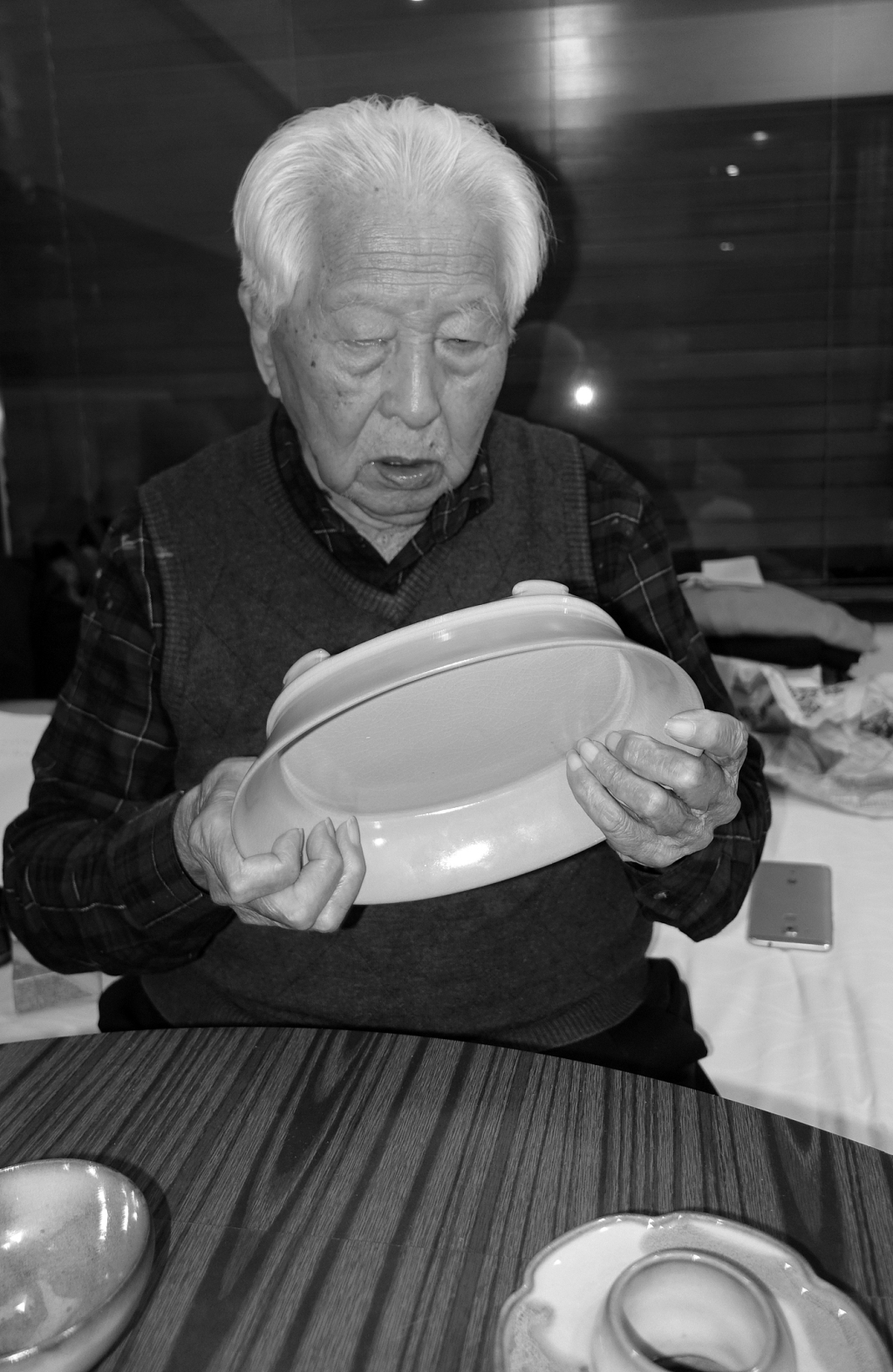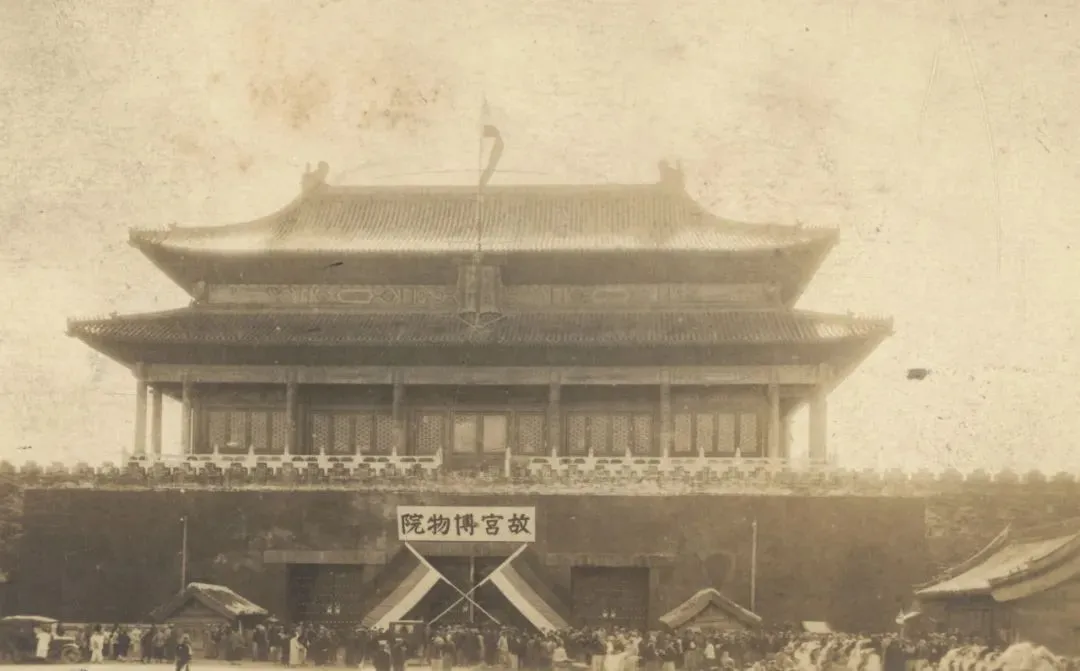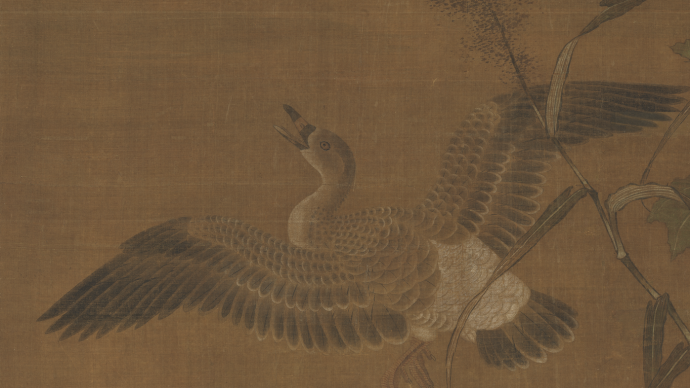
Today is Bailu in the twenty-four solar terms. There is a folk proverb that goes: "In the autumn and windy nights with white dew, wild geese fly in the south". During the white dew season, the heat is fading away, and the autumn is high and refreshing. The geese and swallows wait for the birds to start flying south to escape the cold, and the birds also store food for winter.
"Book of Songs Jianjia" records the beauty of Bailu: "Jianjia is green, and Bailu is frost. The so-called Yiren is on the water side." The geese fly high. The inscription on the "Lu Yan Tu Scroll" written by Cui Bai of the Song Dynasty reads: "The white dew has been frosted, and the jay is roaming alone in the depths. The feathers do not damage the temperament, and do not envy the phoenix in the high hills." Zhu Fu of the Ming Dynasty used "Luzhou Gathering Yan Tu" The pen is light and elegant, and there is a verse in the inscription: "Who is like Xiangpu Minghong, the blue sky flies away and returns."
"The Paper: Ancient Art" specially organizes the famous paintings and calligraphy related to the reed geese collected by the Palace Museum and the National Palace Museum in Taipei for readers.
Song Cui Baiqiu Pu Rongbin axis
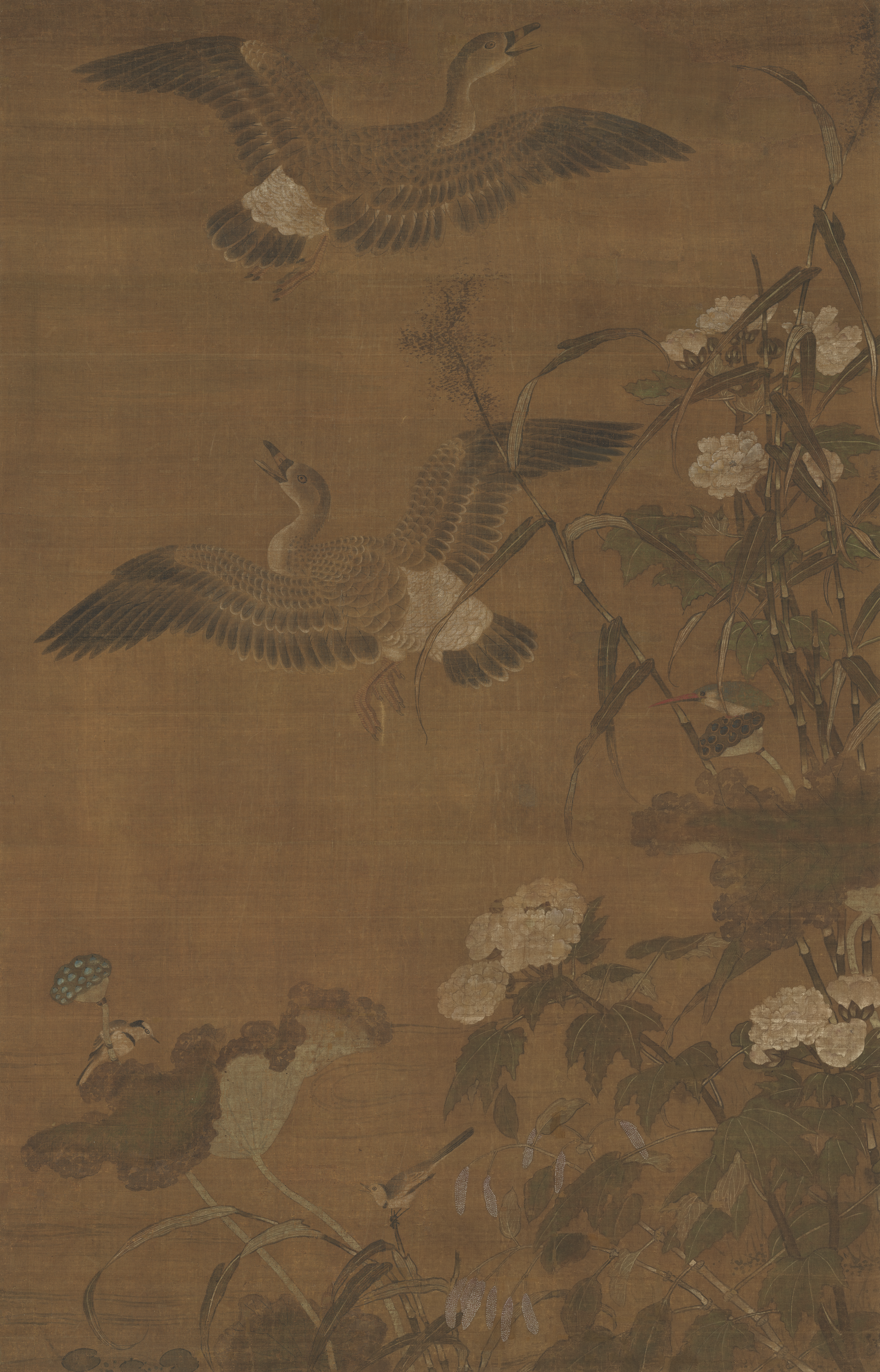
Song Cui Bai Qiu Pu Rong Bin Scroll Collection of the National Palace Museum, Taipei
In this painting, the lotus leaves are withered and yellow, the hibiscus is blooming, and the autumn light is beautiful, the wagtail leaps among the flowers, the jade stays silently, and the two geese flutter in the sky, meaning a thousand miles. There is no painter's seal, the old legend is Cui's work.
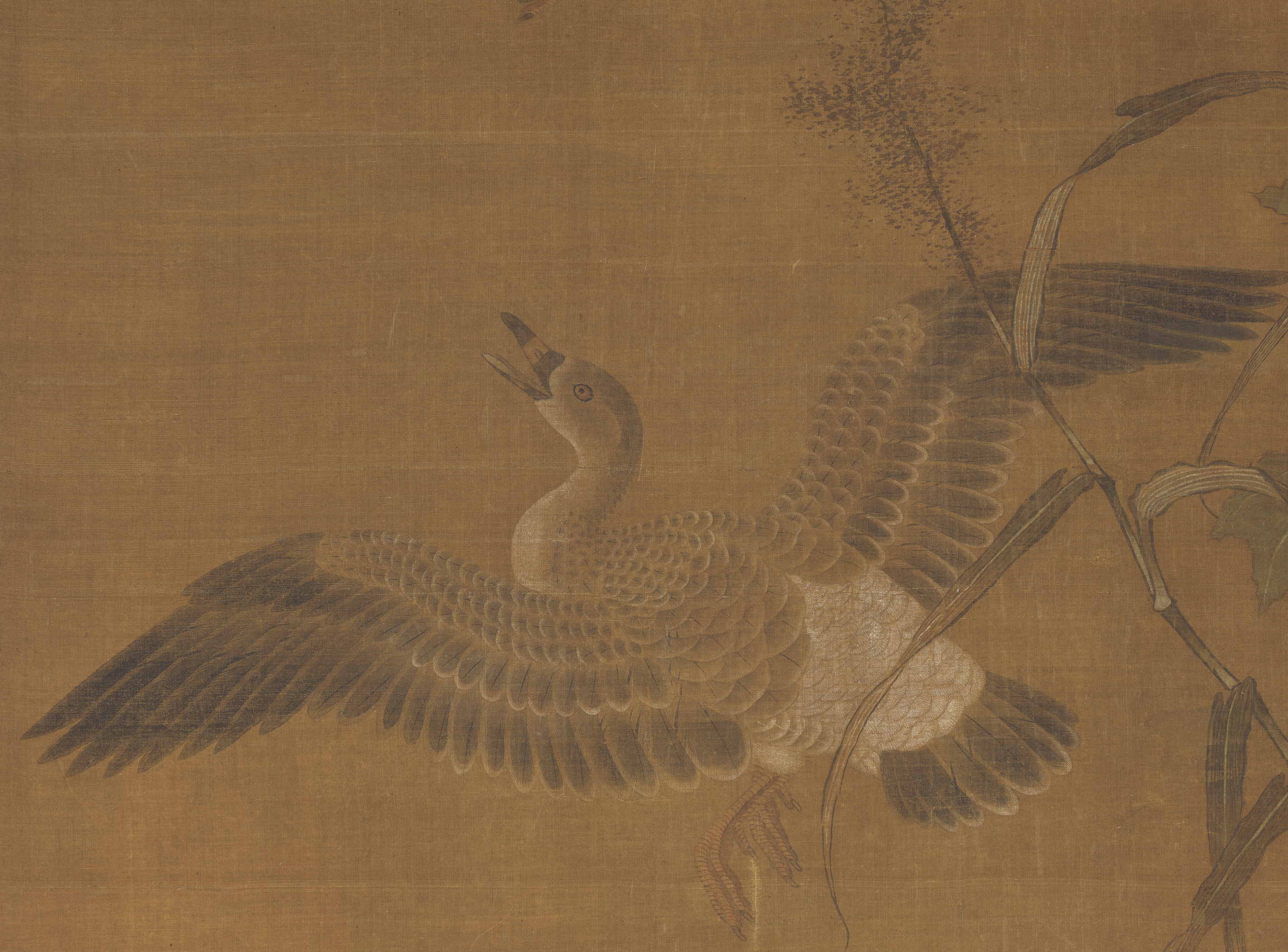
Song Cui Bai Qiu Pu Rong Bin Scroll (detail) Collection of the National Palace Museum, Taipei

Song Cui Bai Qiu Pu Rong Bin Scroll (detail) Collection of the National Palace Museum, Taipei
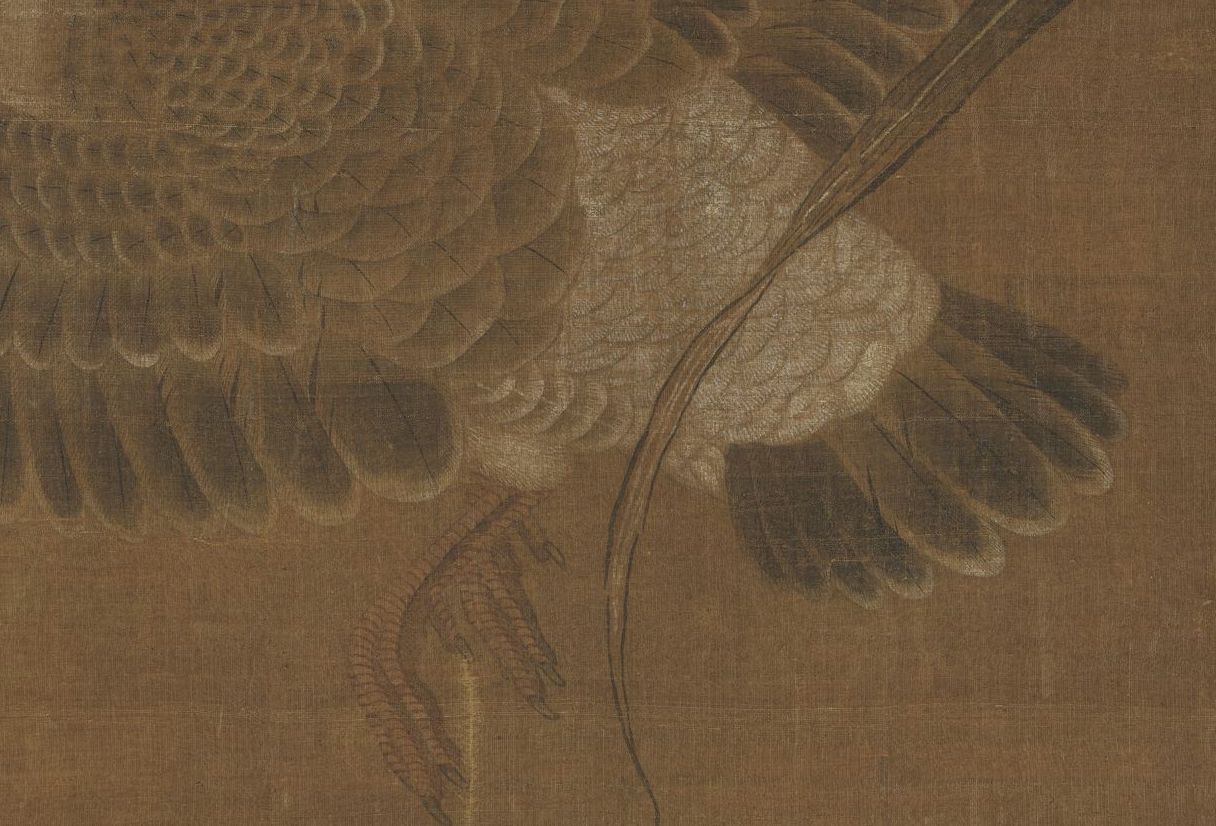
Song Cui Bai Qiu Pu Rong Bin Scroll (detail) Collection of the National Palace Museum, Taipei
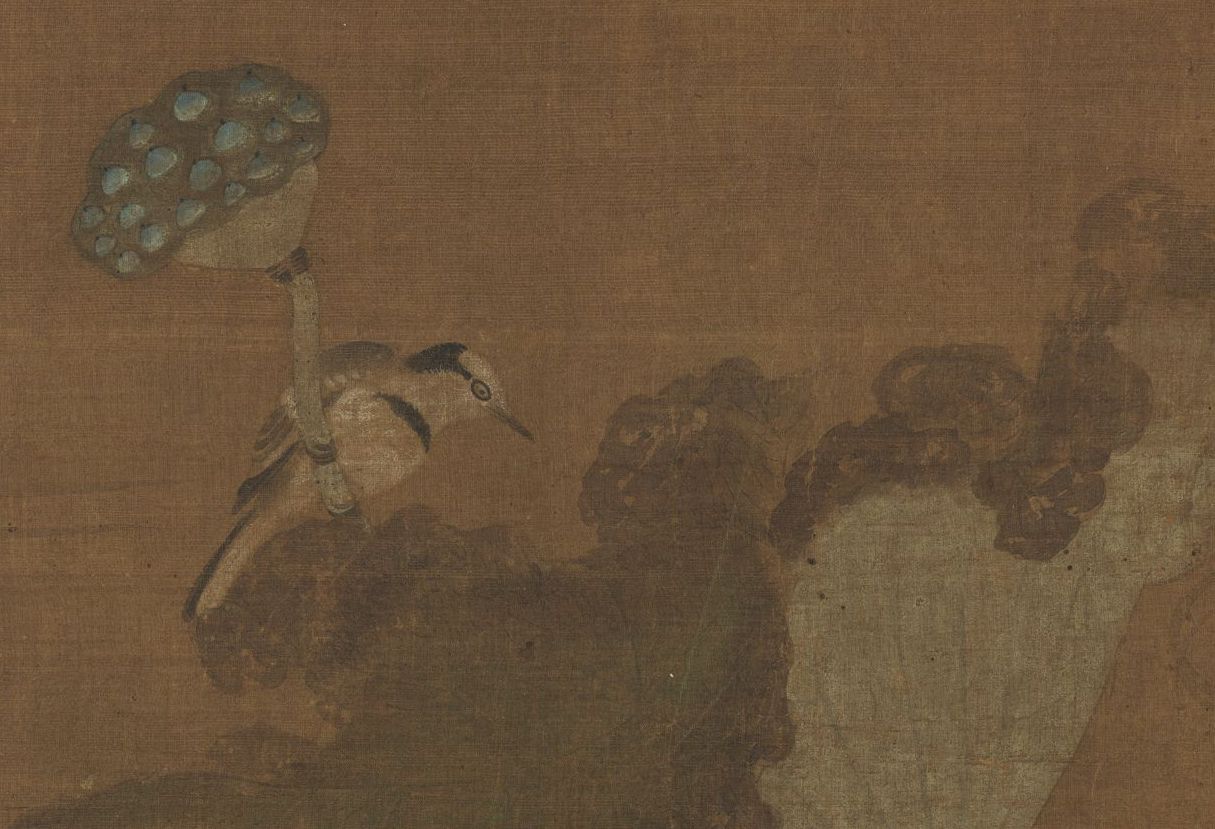
Song Cui Bai Qiu Pu Rong Bin Scroll (detail) Collection of the National Palace Museum, Taipei
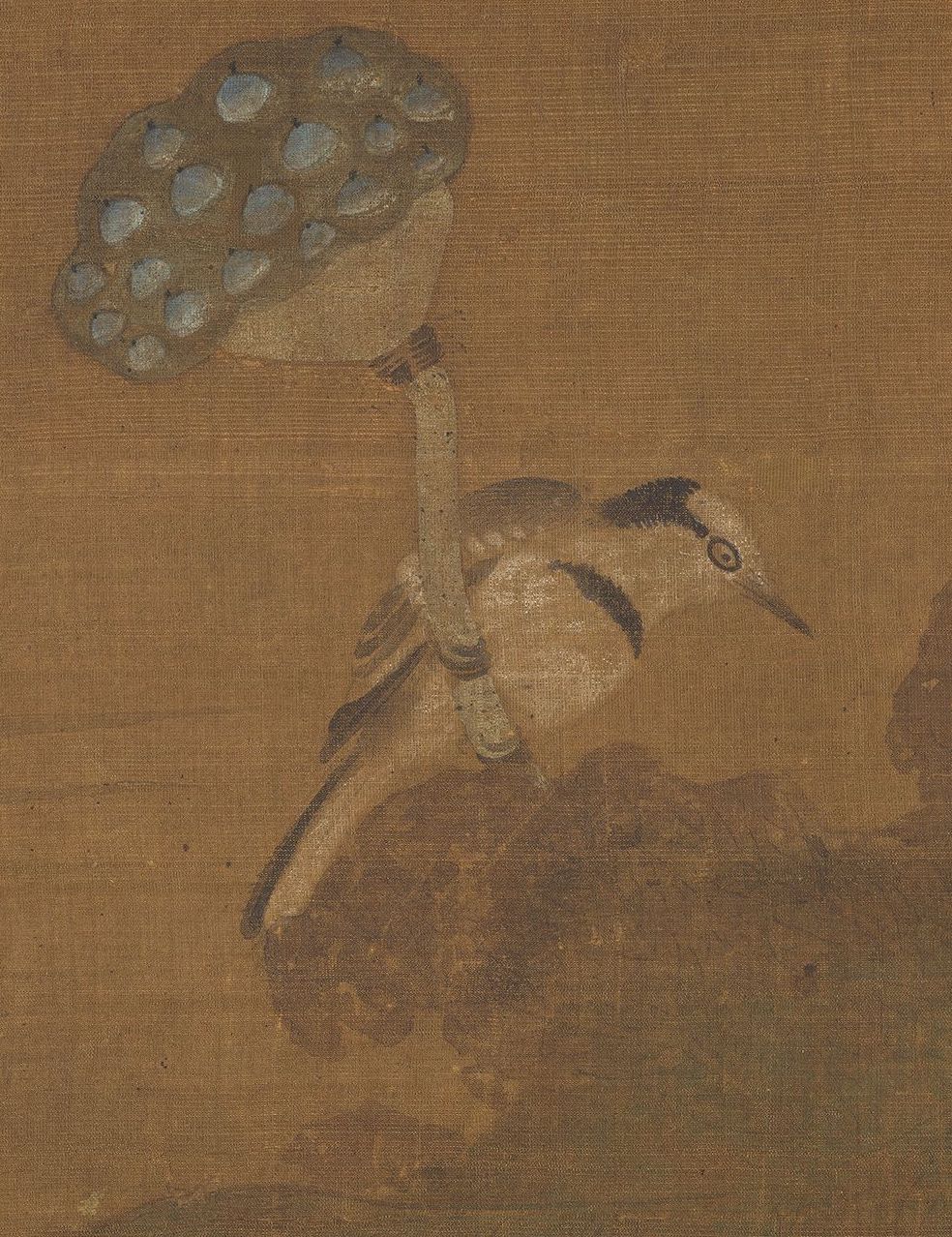
Song Cui Bai Qiu Pu Rong Bin Scroll (detail) Collection of the National Palace Museum, Taipei
Cui Bai (about the eleventh century AD), a native of Haoliang (now Fengyang, Anhui), with the courtesy name Zixi. From Song Renzong to Shenzong, he was a painter in the painting academy. Seiko painting flowers and feathers, especially named after the dry lotus and mallard geese, but also proficient in Taoism, figures, ghosts and spirits. It is said that when he painted, he never had to draft, and he drew long, straight and firm lines without the use of a ruler.
Song Cui Bai Lu Yan Axis
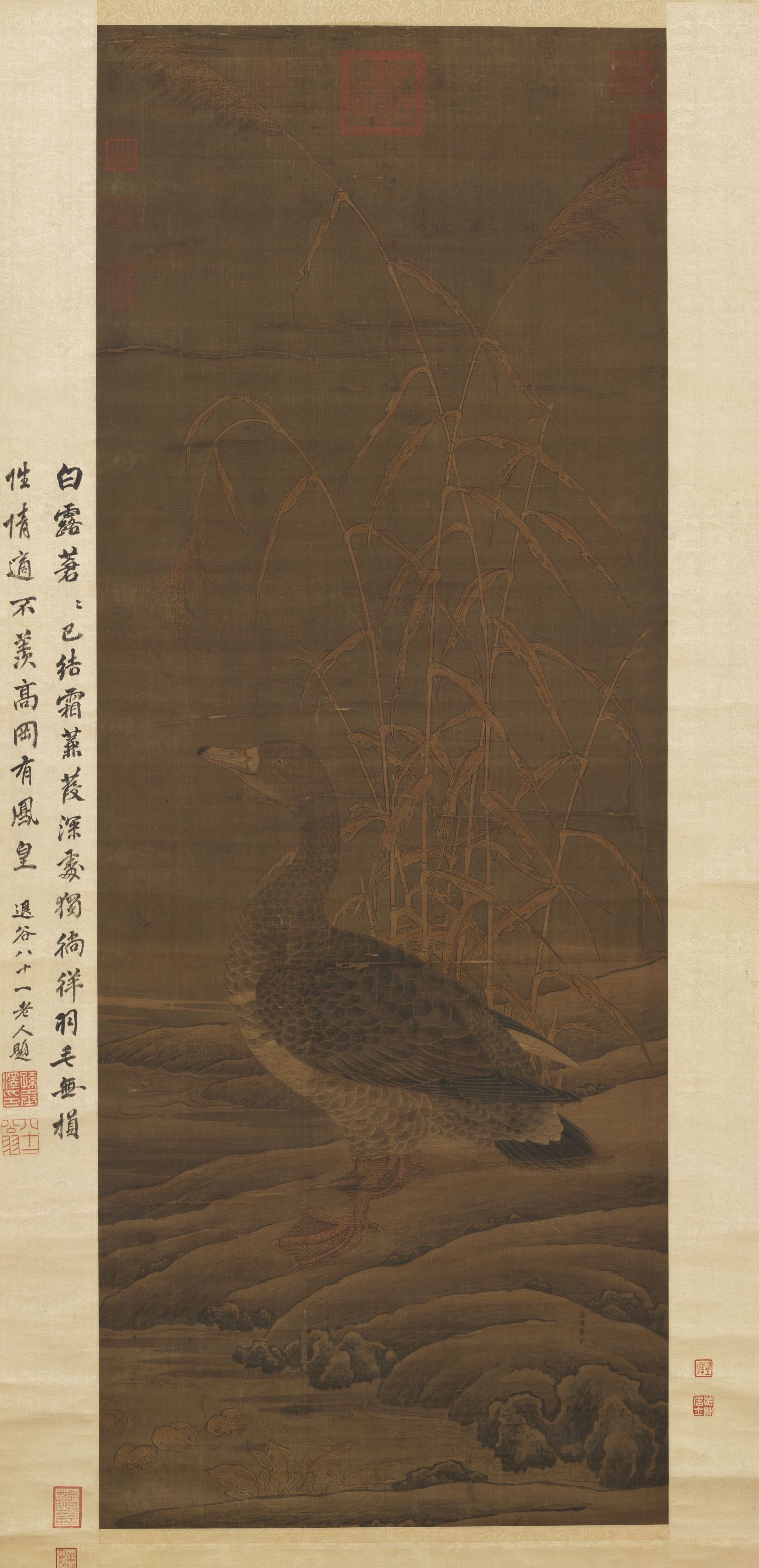
Song Cui Bai Lu Yan Axis Collection of the National Palace Museum, Taipei
Under the reed bushes on the waterfront, a lone wild goose lingered and stopped. The geese are first hooked into outlines with thick and light ink, then stained with water ink, and then filled with ochre and cyan, showing the luster of the plumage. The silk ground is dyed with light ink, making the background more obvious and giving the feeling of being enveloped by cold air. There are inscriptions "Haoliang Cui Bai" on the slope stone.
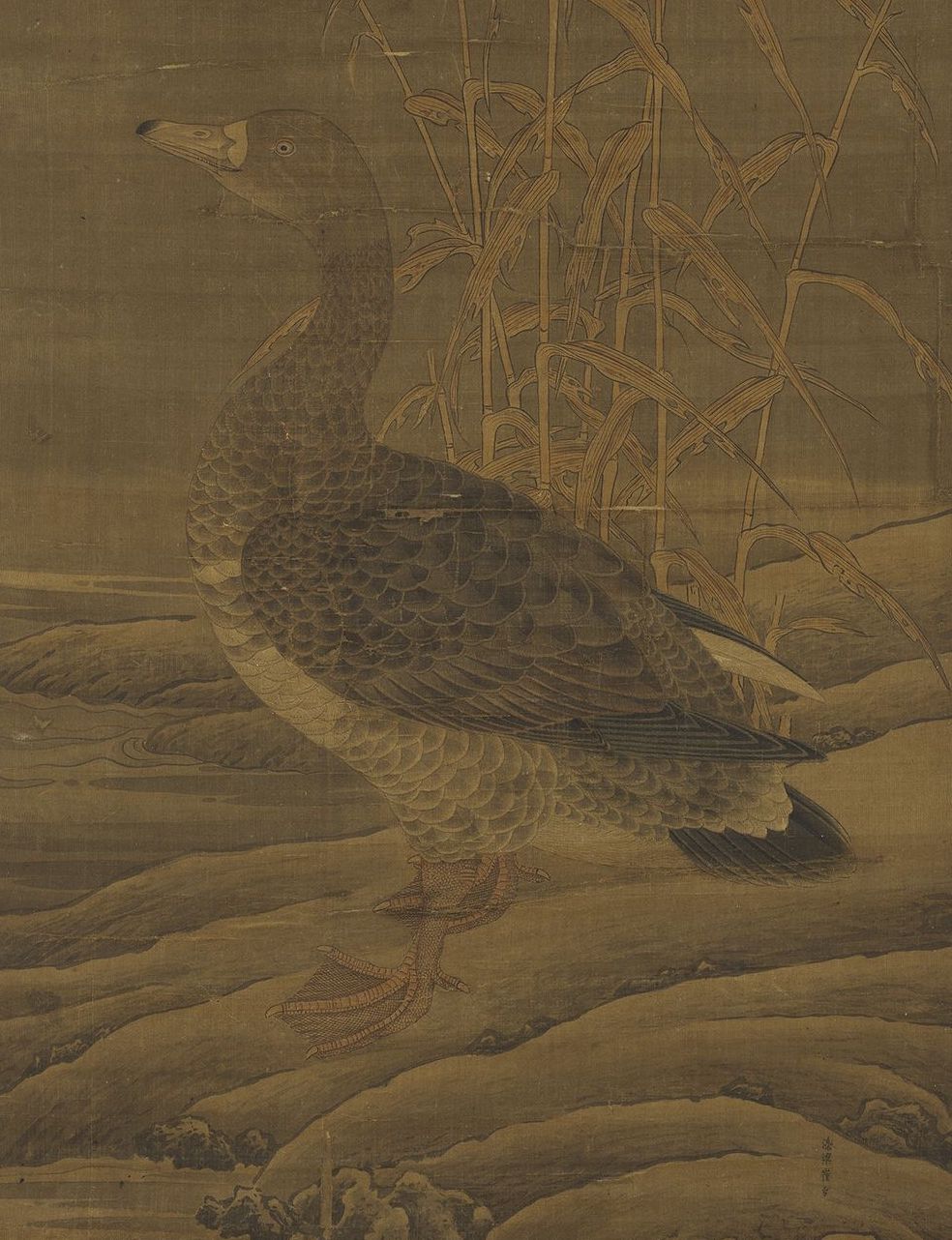
Song Cui Bai Lu Yan Scroll (detail) Collection of the National Palace Museum, Taipei
This painting has an inscription and postscript by Sun Chengze: The white dew is covered with frost. Jianjia roams alone in the depths. Feathers do not damage temperament. Do not envy Takaoka has a phoenix. Back Valley Eighty-One Elder Questions.
(Biography) Song Cui Bai Luting Su Yan axis
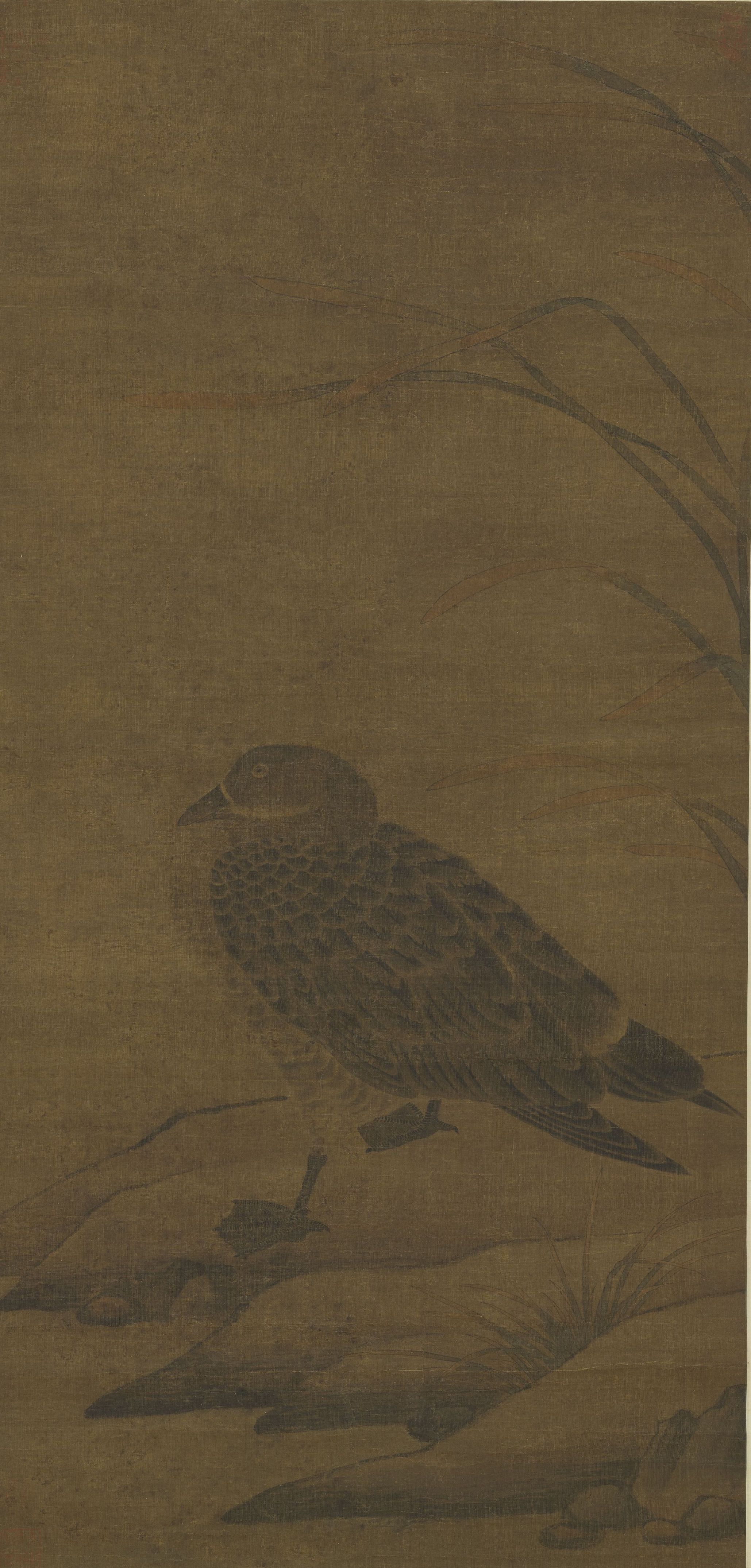
(Biography) Song Cui Bai Lu Ting Su Yan Axis Collection of the National Palace Museum, Taipei
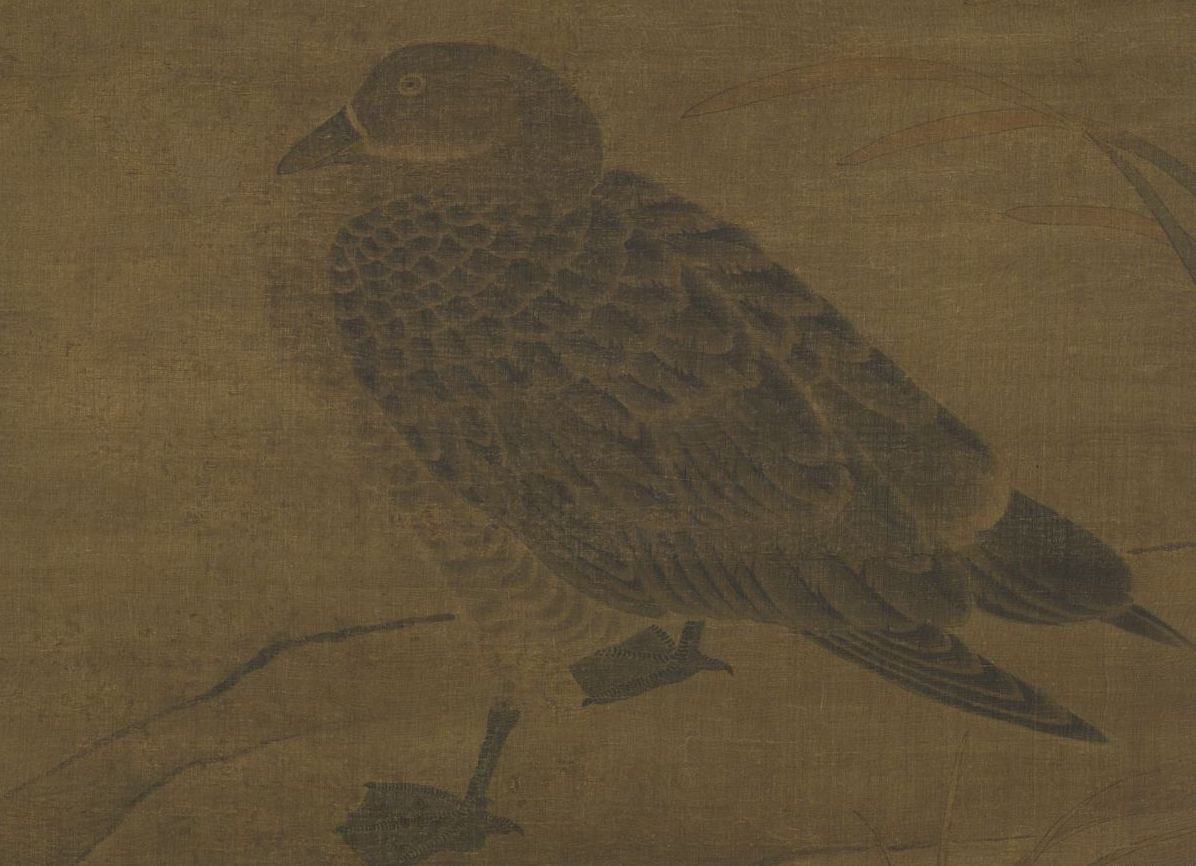
(biography) Song Cui Bai Lu Ting Su Yan Axis (detail) Collection of the National Palace Museum, Taipei
Cui Bai got his name for his ability to paint withered lotus and wild geese, so later generations often attribute works of this type to his name, and this painting is an example. Po'an and Luyan, which are all simple in composition, are not similar to Cui Bai's realistic brush and ink style, but have the feeling of primitive simplicity in the Yuan Dynasty.
Song Dynasty Autumn Lotus Wild Mallard Chart Scroll
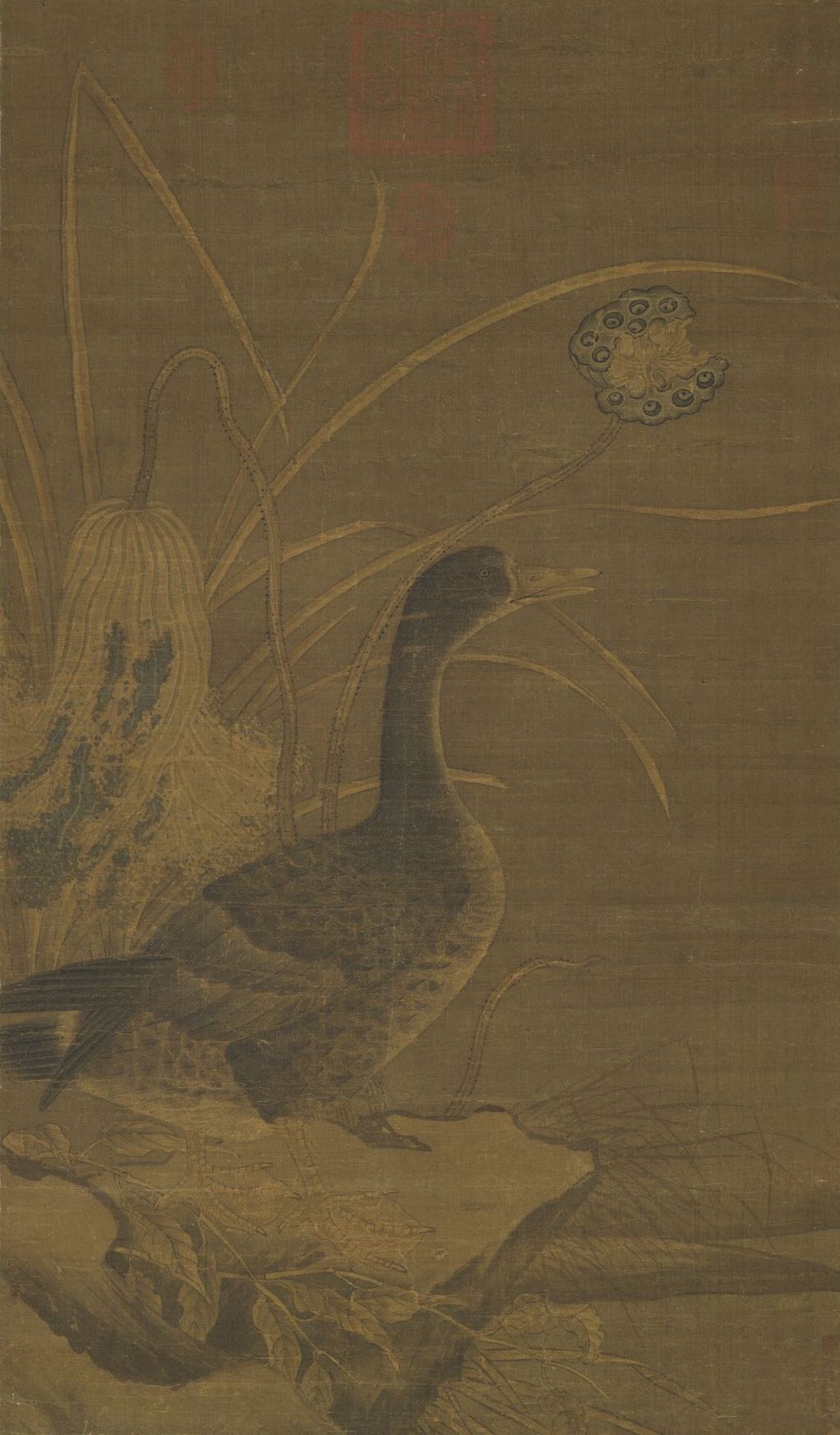
Song Dynasty Autumn Lotus Wild Mallard Scroll Collection of the National Palace Museum, Taipei
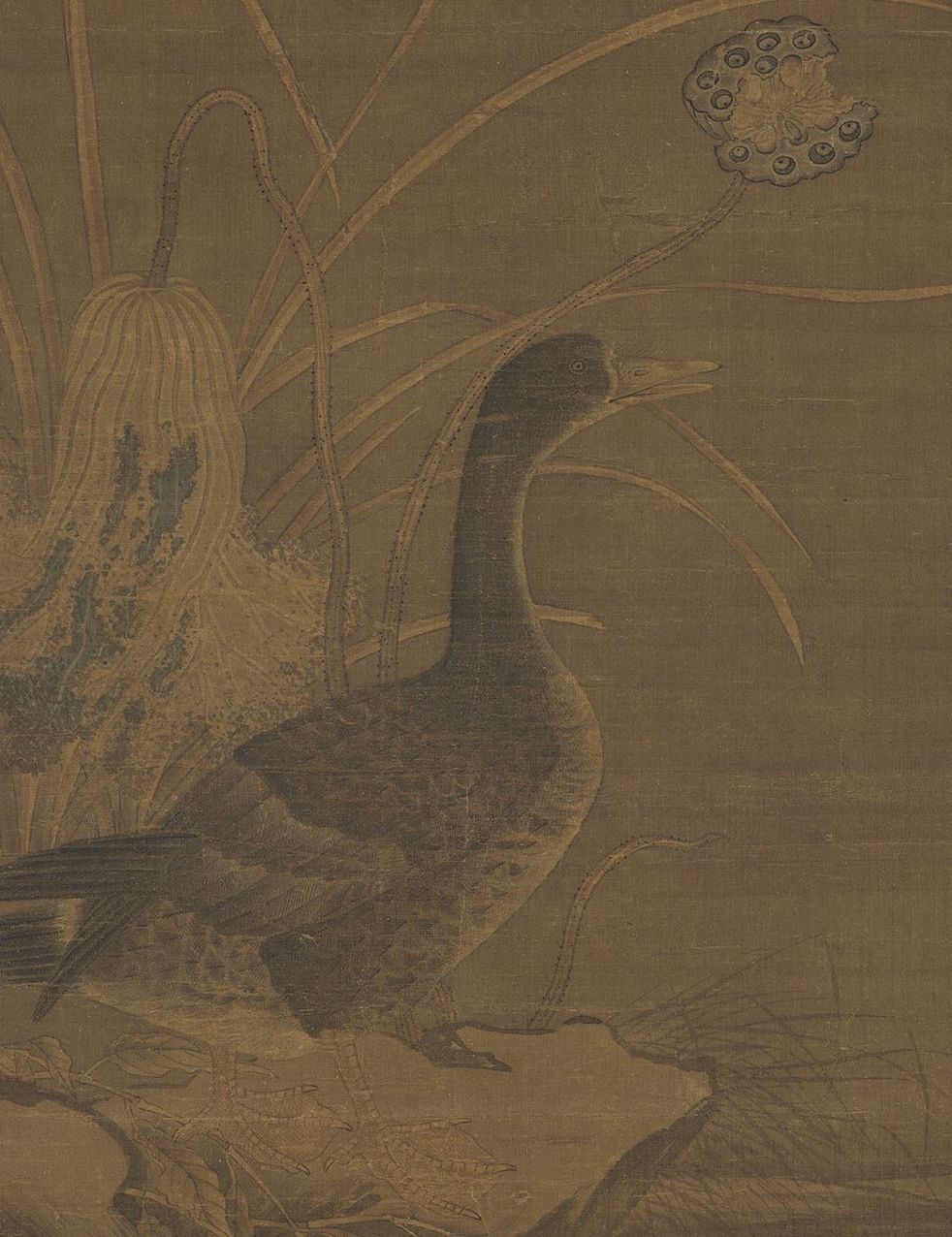
Song Dynasty Scroll of Autumn Lotus and Wild Mallards (Part) Collection of the National Palace Museum, Taipei

Song Dynasty Scroll of Autumn Lotus and Wild Mallards (Part) Collection of the National Palace Museum, Taipei
A wild goose staggered to the flat stone raised by the water, staring into the distance, not knowing whether it was looking for something or waiting for something, its expression was sincere and quite touching. The wild goose feet are stepping on the red polygonum flowers, and the back is set against the leftover leaves and lotus awnings. The method of painting geese is filled with double hooks. The color is mainly ink, with a little ocher and cyan. This method is also used for other scenes. Only painting grass is closer to the boneless method. It is not only precise but also vivid. Although the picture is a little dark due to its age, it still does not lose the charm of Song Dynasty paintings.
Song Dynasty painting Qiutang double geese axis
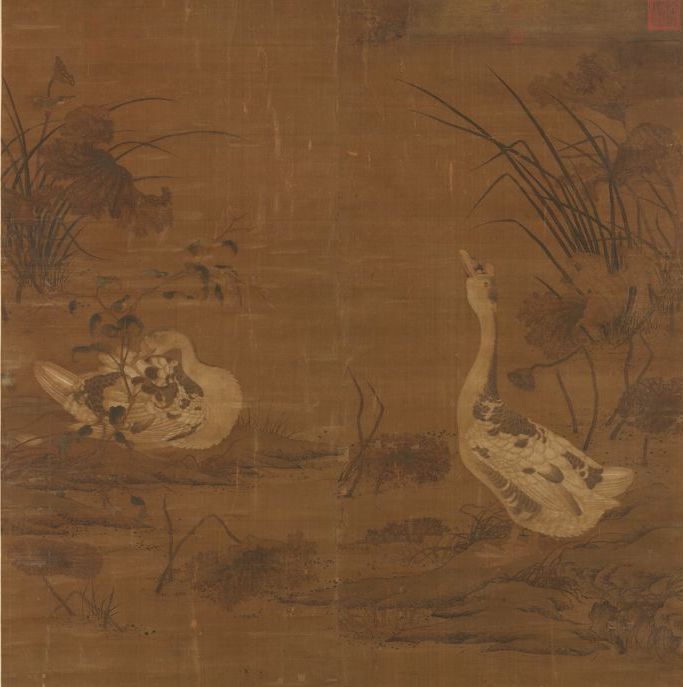
Song Dynasty Painting Qiutang Double Wild Goose Scroll Collection of the National Palace Museum, Taipei
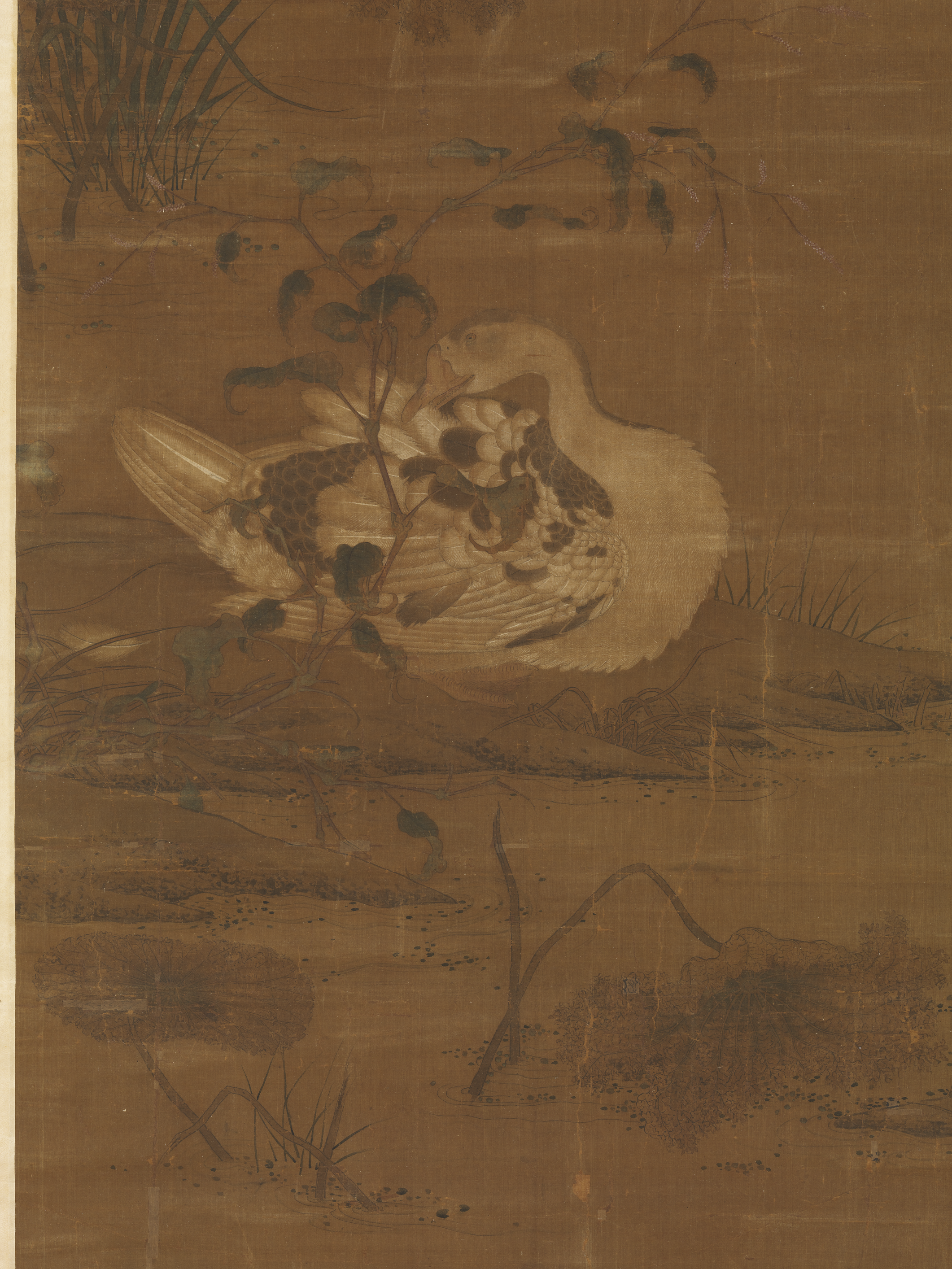
Song Dynasty Painting Autumn Pond Double Wild Goose Scroll (Part) Collection of the National Palace Museum, Taipei
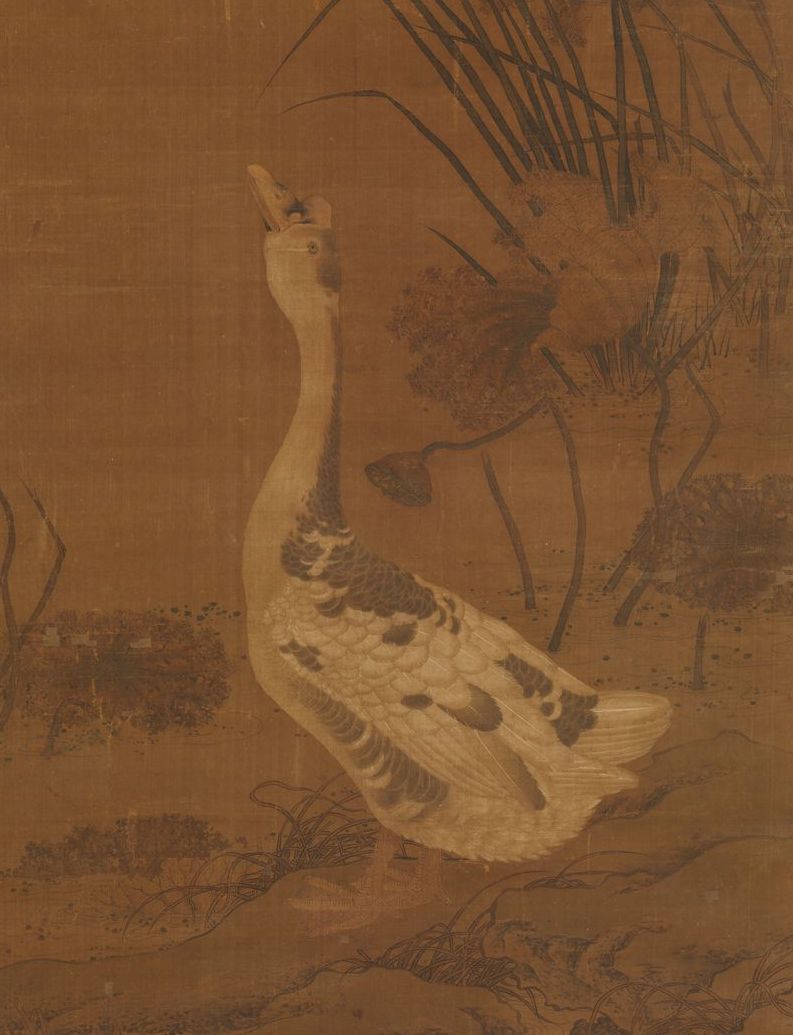
Song Dynasty Painting Autumn Pond Double Wild Goose Scroll (Part) Collection of the National Palace Museum, Taipei
Paint a corner of a quiet pond in autumn, with yellow reeds, red polygonum, withered lotus and white geese. Although this painting depicts a pair of geese, the geese and geese are of the same family, and the ancients often did not distinguish between geese and geese. The whole work is mellow in color, dotted with ink, the shape is elegant and realistic, and the expression is vivid and realistic, showing the artist's realistic ability to deeply observe nature. This piece is a work of two pieces of silk spliced together. From its empty and flat landscape, it has the interest of a barren and cold waterscape. It can be regarded as the work of the painting academy of the Huizong Dynasty (1102-1126) in the Northern Song Dynasty. It is the existing water bird in Tingzhu of the Northern Song Dynasty. Rare representative work.
Song Dynasty Hantang group of wild geese
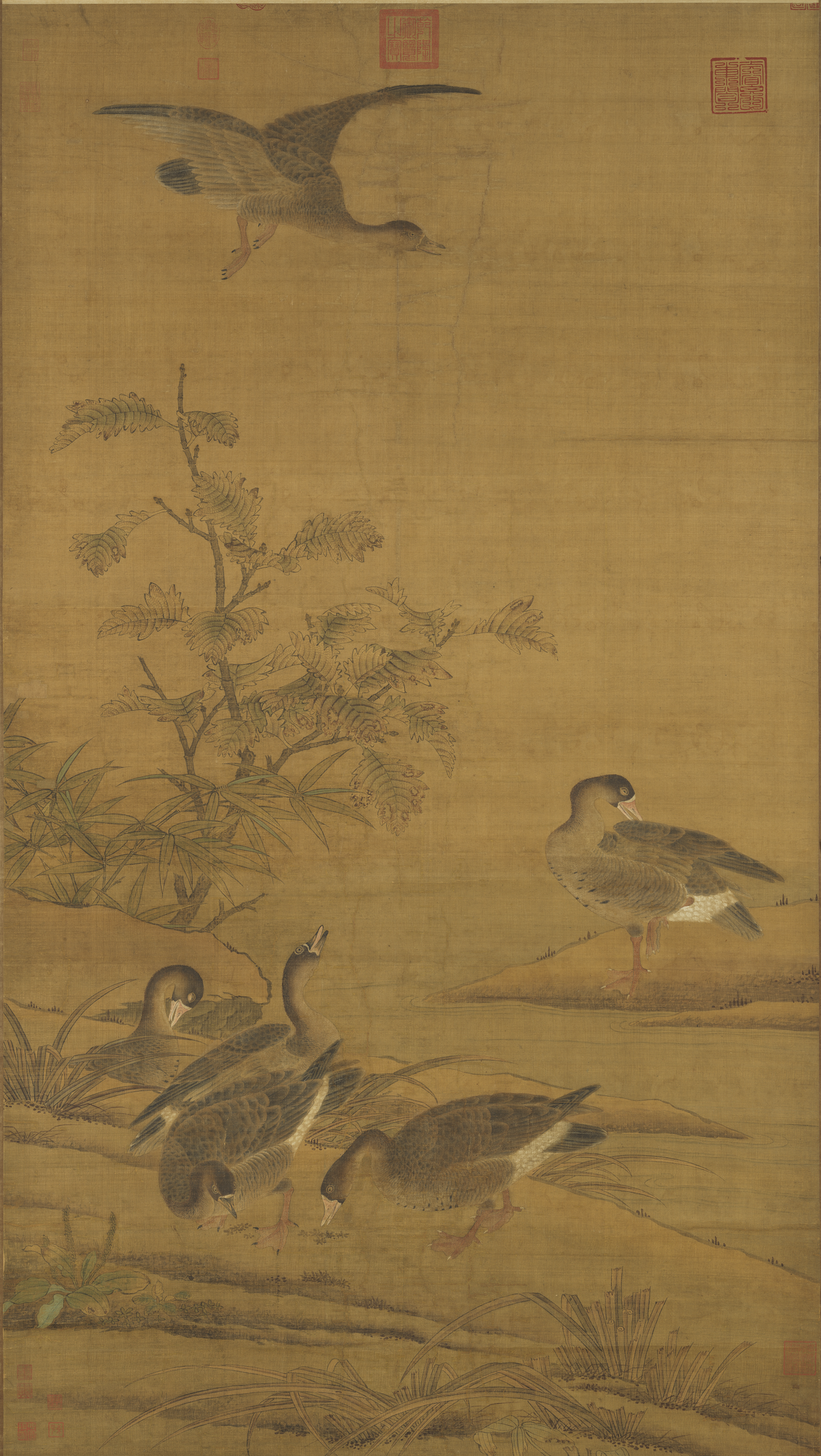
Song Dynasty Hantang group of wild geese in the collection of the National Palace Museum, Taipei

A Scroll of Geese in Hantang, Song Dynasty (part) Collection of the National Palace Museum, Taipei
In one corner of the pond, withered grass and dead leaves adorn the poolside, it is quite chilly. A few wild geese gathered in groups, and one geese came flying into the sky, echoing with those who stretched their heads and raised their heads, forming a vivid picture.
(Biography) Song Huangju Picking Reed and Wild Goose Axis

(Biography) Song Huangju Picking Reed and Wild Goose Scroll Collection of the National Palace Museum, Taipei
There are three geese perched on the sandy shore, one shrunken and resting, and the second one looks to the side, as if watching and alerting. On the shore, only three or five reeds can be seen, and the scene is desolate and sultry. The shape of the wild goose, the use of the brush and the brushwork of the wild wild goose in this painting have the meaning of Lv Ji (active in 1439-1505), a famous court flower and bird painter in the middle Ming Dynasty. However, the commonly used axe-splitting method is not seen in the chapped stone. The brush strokes for painting geese are smooth, and the lines of the reed and the stone are more undulating and Teton, especially the water pattern is the most obvious, so it may be done by a later imitator of Lu.
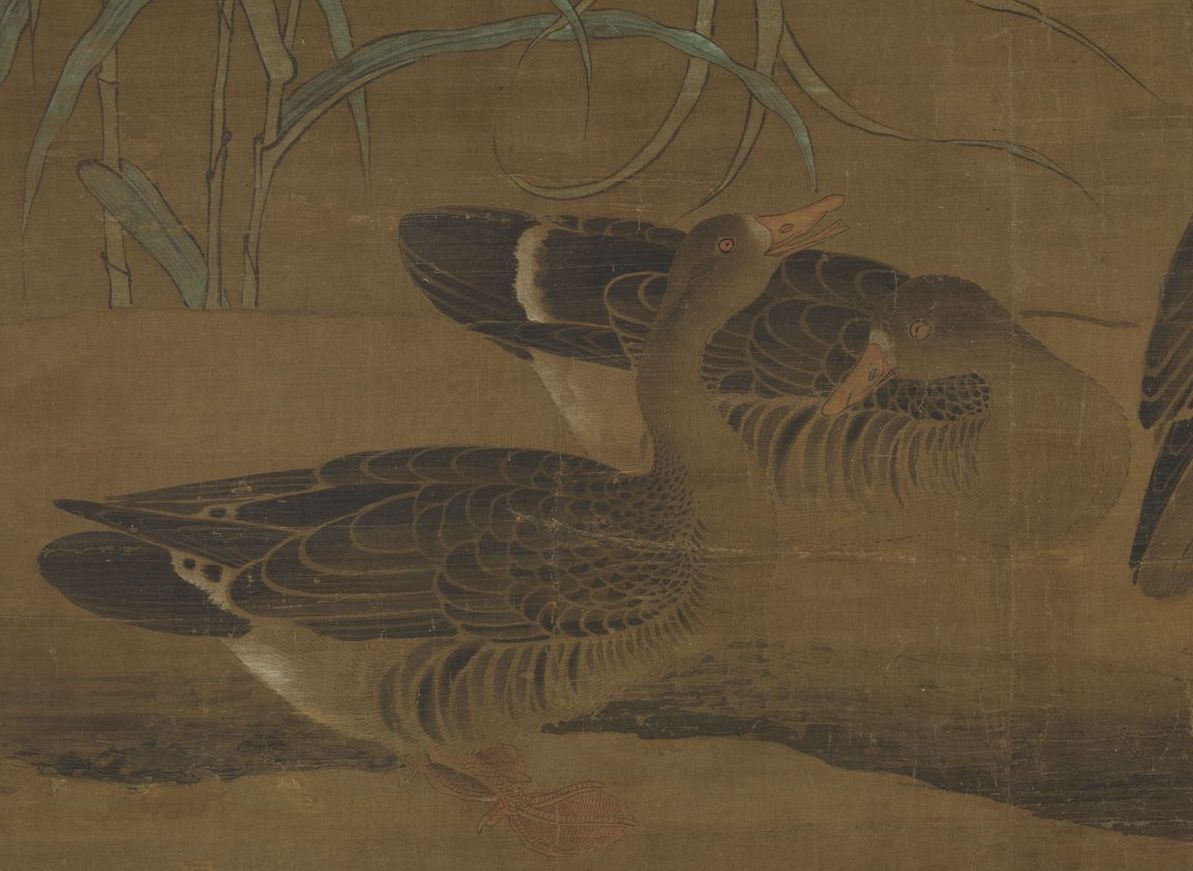
(Biography) Song Huangju Picking Reed and Wild Goose Scroll (Part) Collection of the National Palace Museum, Taipei

(Biography) Song Huangju Picking Reed and Wild Goose Scroll (Part) Collection of the National Palace Museum, Taipei
This painting was previously marked as the work of Huang Jucai. Huang Jucai (after 933-993), a native of Chengdu, Sichuan, whose courtesy name is Boluan. He was the son of Huang Quan (903-965), and he was able to learn from the family. Shi and his father's colleague Meng Shu (934-965) were under imperial edict. Shu died and entered the Song Dynasty. When Taizong's family met, he was entrusted with the responsibility of searching and visiting famous paintings and interpreting the items. The paintings of Huang Quan and Ju Cai's father and son became the standard for the quality of art in the early Song Dynasty.
Yuanwu Town Reed Flowers and Cold Wild Goose Chart Axis
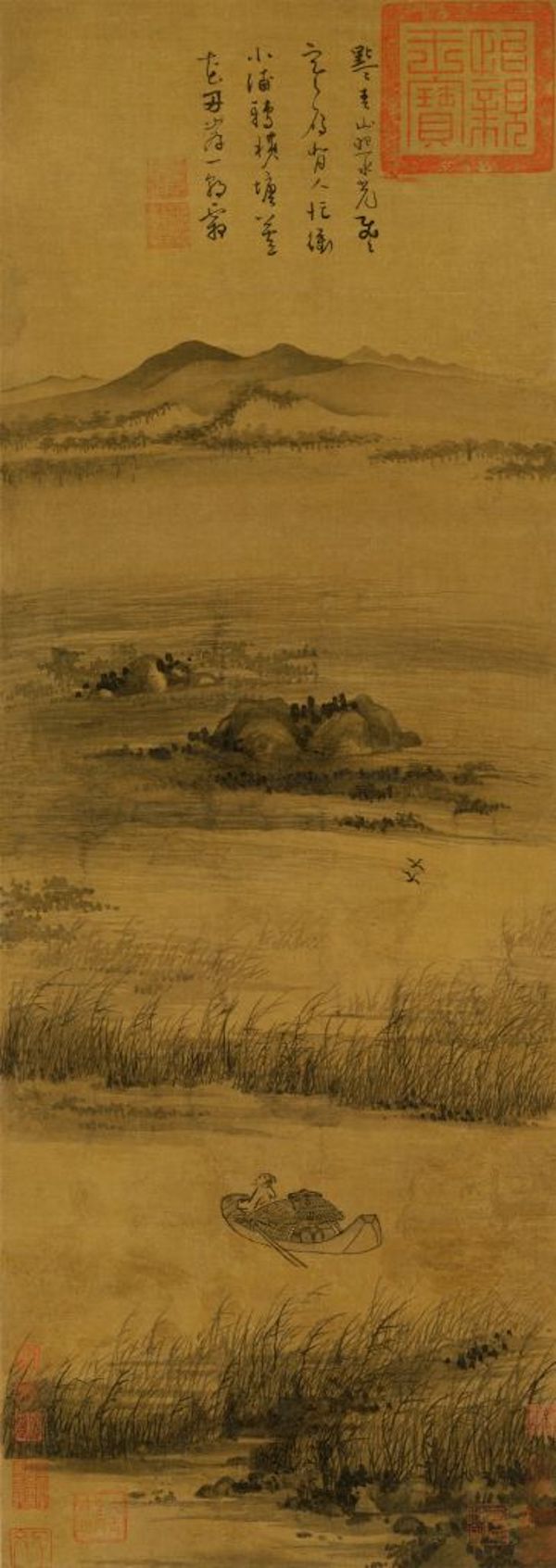
Yuanwu Town Reed Flower and Cold Wild Goose Scroll Collection of the Palace Museum
This painting is self-titled: "A little bit of green hills shines on the water, and geese flying and geese are busy behind people. Chong Xiaopu, turn to Hengtang, and there is frost on both sides of the reeds." There are 11 parties including "Prince Yi Bao", "Huang Shi Zhongming" and "Xu Zhai Examination and Approval" in the collection of Qianjian.
Using the Pingyuan method to paint the autumn waterfront scenery, the water surface is rippling, the lilies are green, a pair of reed geese are flying, and the fisherman is staring up at the head of the boat. The picture is ethereal and cold, forming a state of plain and distant. In the picture, the method of setting the scene in parallel is used to express the vast and endless water, and the ink and wash of varying shades are used to express the level of far and near.
"The Continuation of Moyuanhuiguan" and "The Famous Paintings of Xuzhai" are recorded.
Yuan Wangyuan Hanjiang Luyan Axis
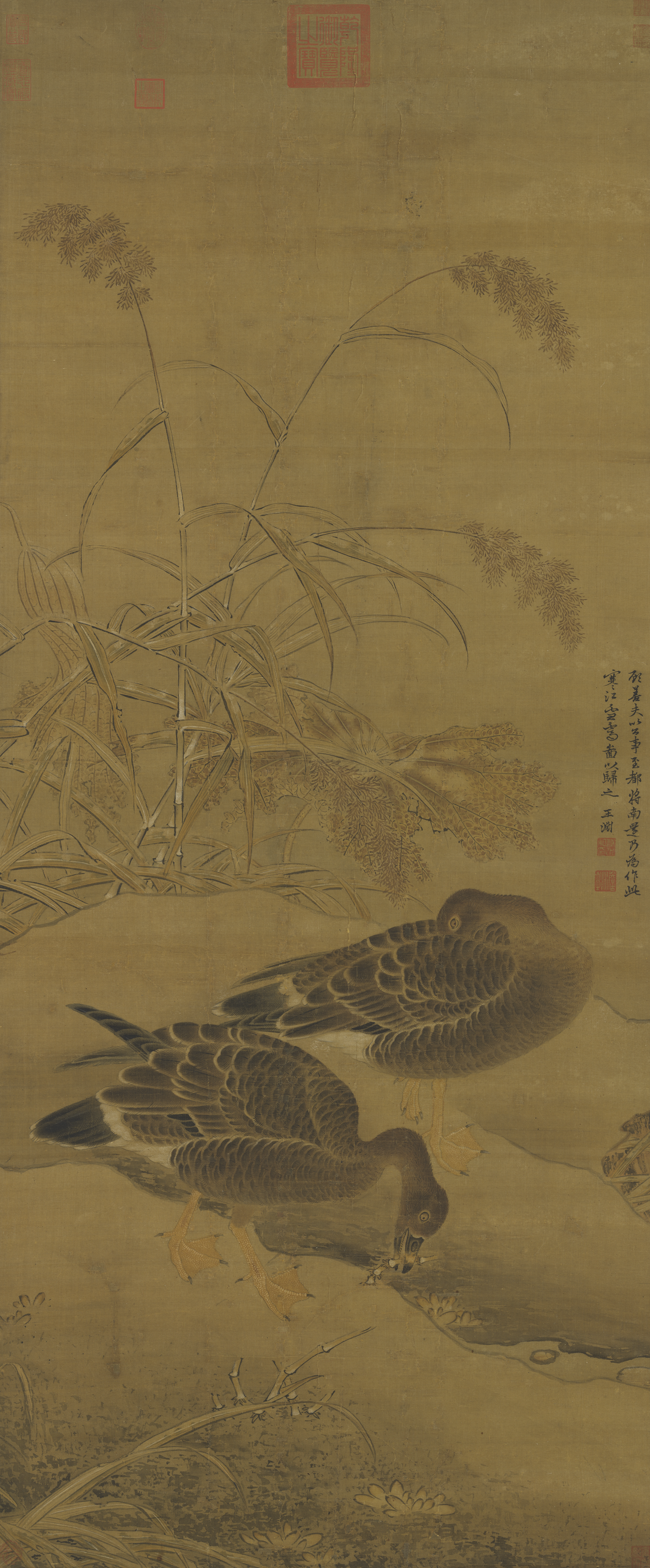
Yuan Wangyuan Hanjiang Luyan Axis Collection of the National Palace Museum, Taipei
Wang Yuan (about the 14th century), a native of Qiantang (now Hangzhou), Zhejiang Province, with the word Rushui and his name is Danxuan. When studying painting, he was instructed by Zhao Mengfu and learned many ancient painting methods.
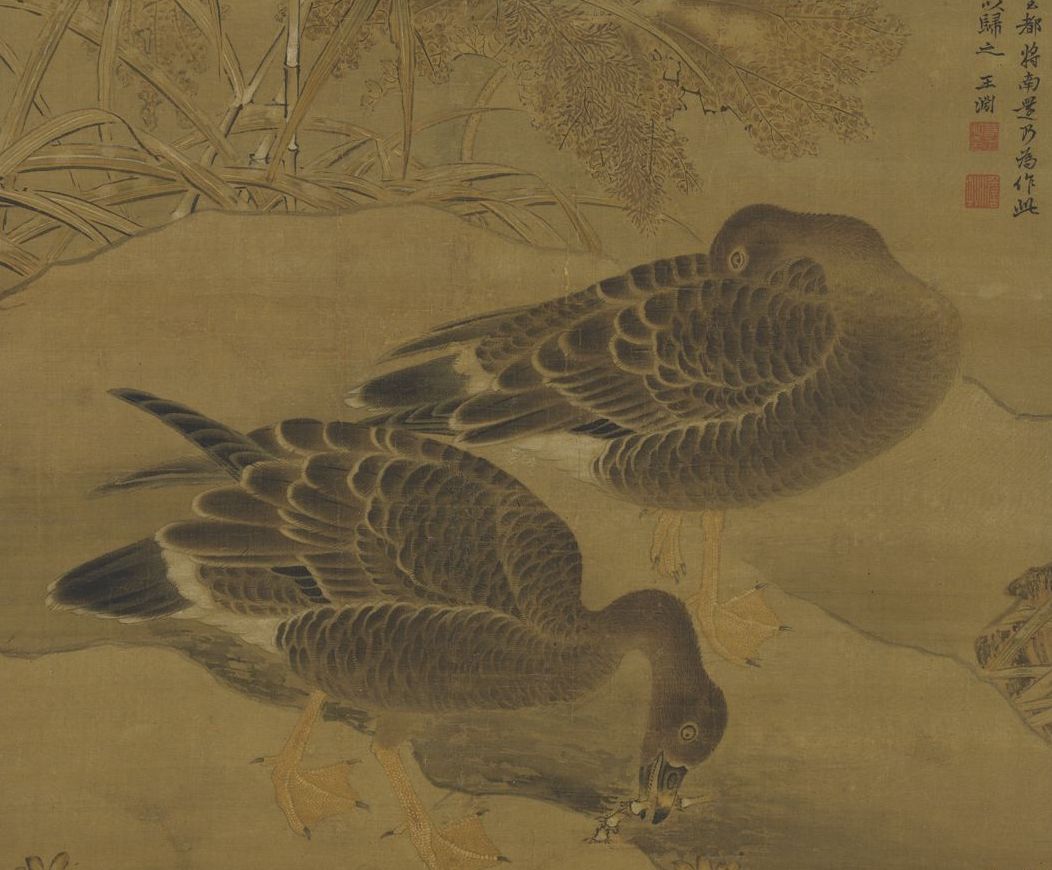
Yuan Wangyuan Hanjiang Luyan Axis (detail) Collection of the National Palace Museum, Taipei
This frame depicts two geese on the waterfront, one stretches its neck to peck at the roots of a reed, and half closes their eyes and rests. The feathers are plump and lively. Three or two stems of reeds set off behind it, and there are a few leaves of residual lotus, which increases the mood of bleakness.
Yuan people's painting of a hundred wild geese

Yuan people painting Hundred Wild Goose Scroll Collection of the National Palace Museum, Taipei
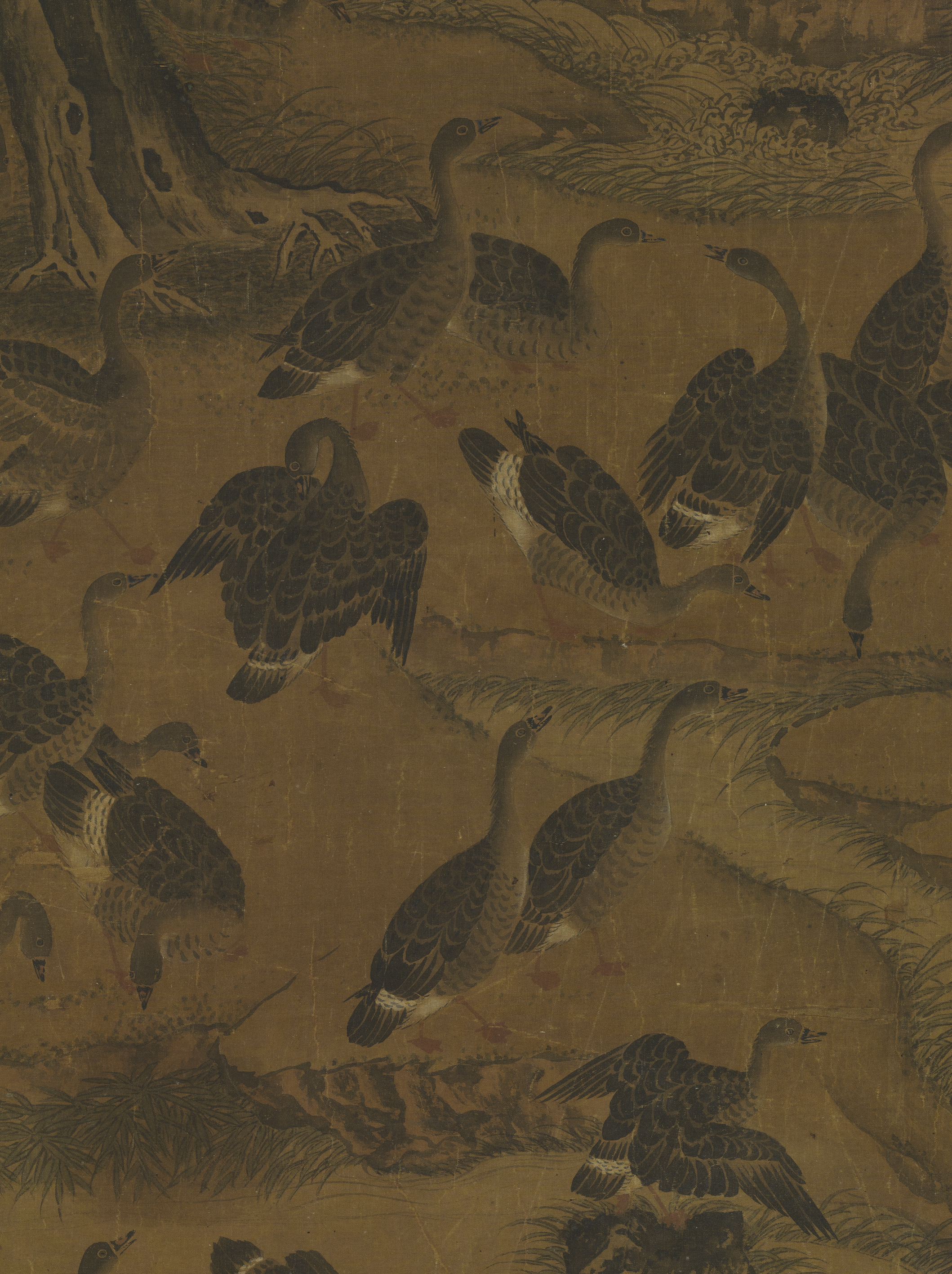
Yuan people painting a hundred wild geese scroll (detail) Collection of the National Palace Museum, Taipei

Yuan people painting a hundred wild geese scroll (detail) Collection of the National Palace Museum, Taipei
Yuan people painting reed and wild goose axis

Yuan people painting reed and wild goose scroll (detail) Collection of the National Palace Museum, Taipei

Yuan people painting reed and wild goose scroll (detail) Collection of the National Palace Museum, Taipei
Yuan people shooting wild goose
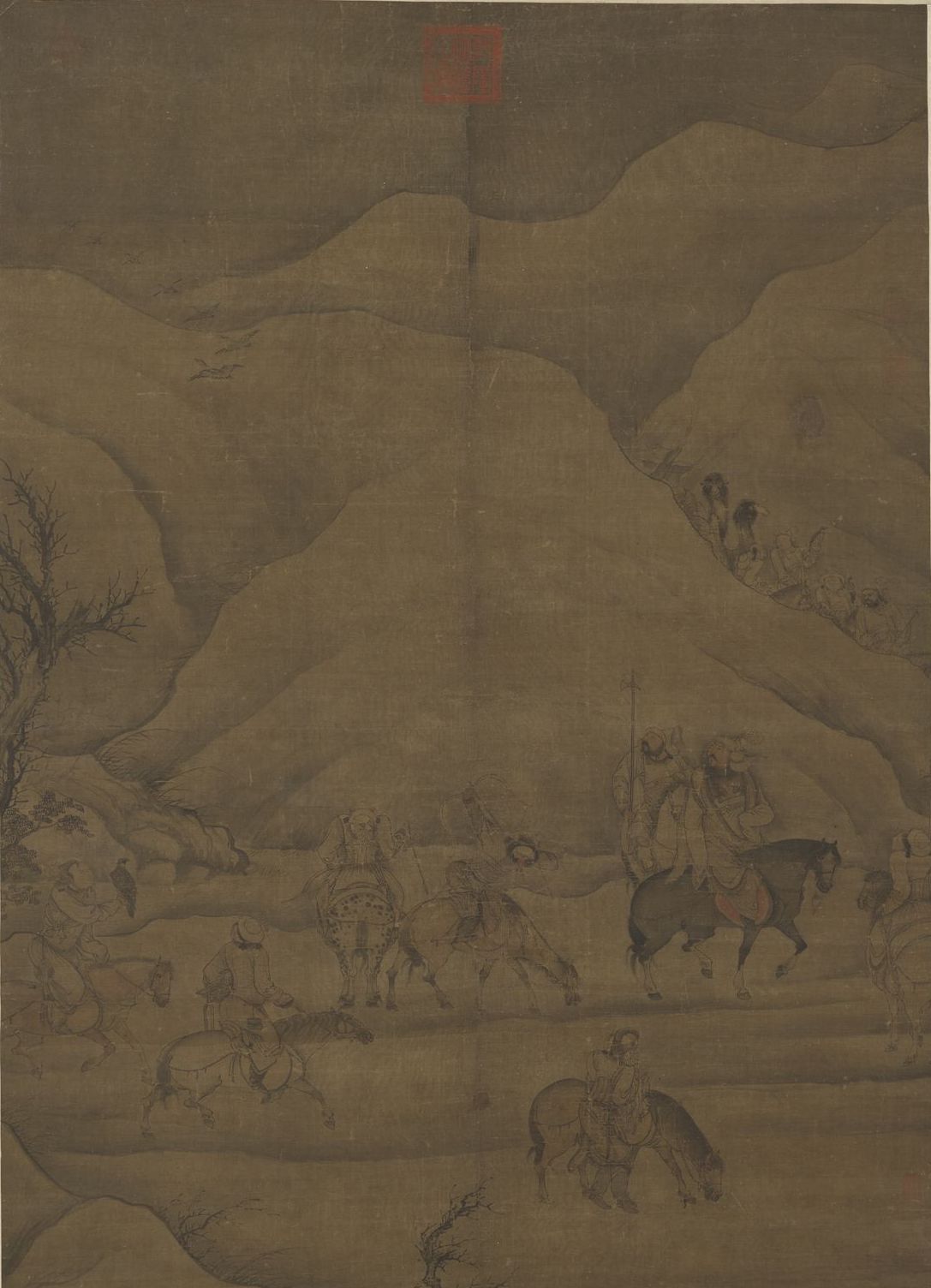
Yuan People Shooting Wild Goose Scroll Collection of the National Palace Museum, Taipei
Surrounded by mountains, a group of hunting teams are slowly marching along the mountain road. In the cavalry team, someone spotted the wild geese flying in the sky, and immediately drew their bows, ready to go. The rest of the crowd, some stood and looked up, with a focused expression, and some manipulated the falcon, ready to respond at any time. The painter obviously intends to use the description of the surrounding scenery to set off the chilling atmosphere of the whole work. Therefore, whether it is the craggy mountains or the trees, the brush strokes are extremely simplified, and the topographical features of the northern desert have been successfully created. The emperor of the Yuan Dynasty liked hunting, and had repeatedly called on painters to draw pictures to record the grand occasion at that time.
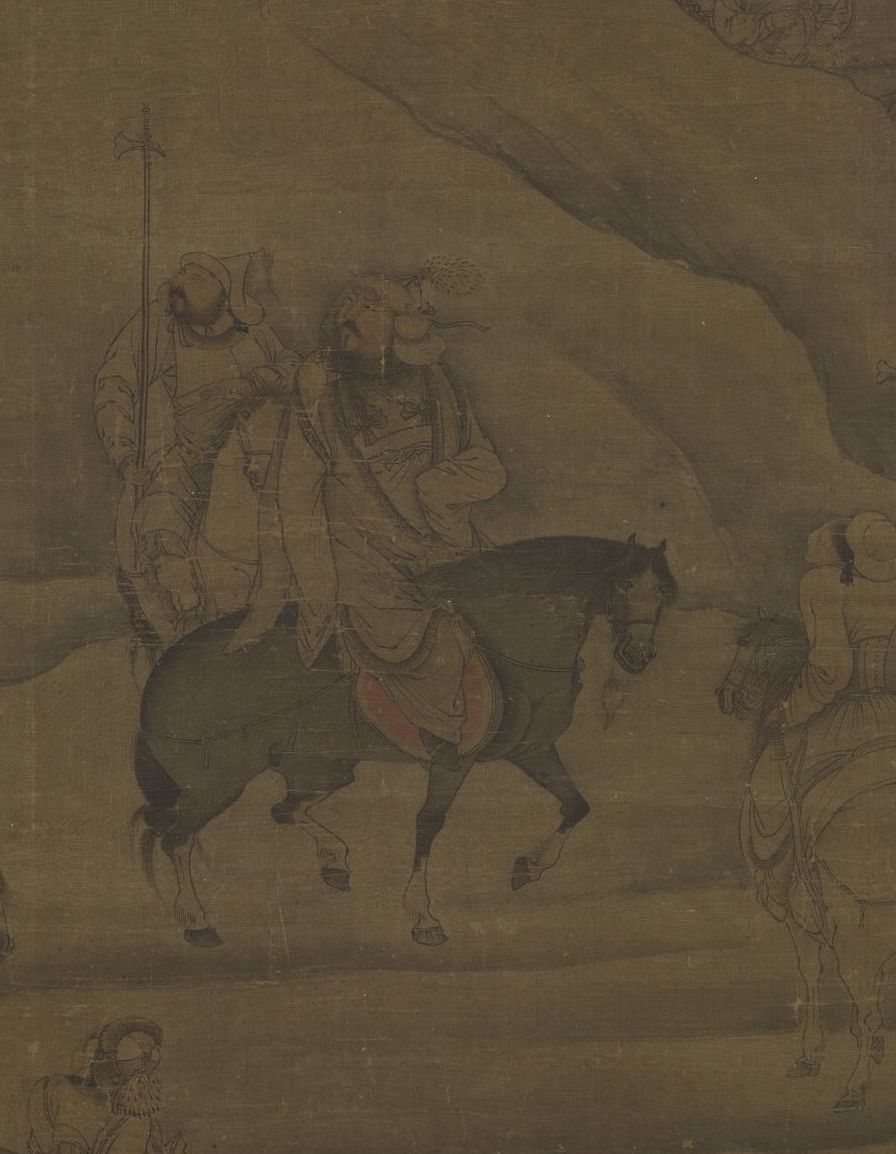
Yuan People Shooting Wild Goose Scroll (detail) Collection of the National Palace Museum, Taipei
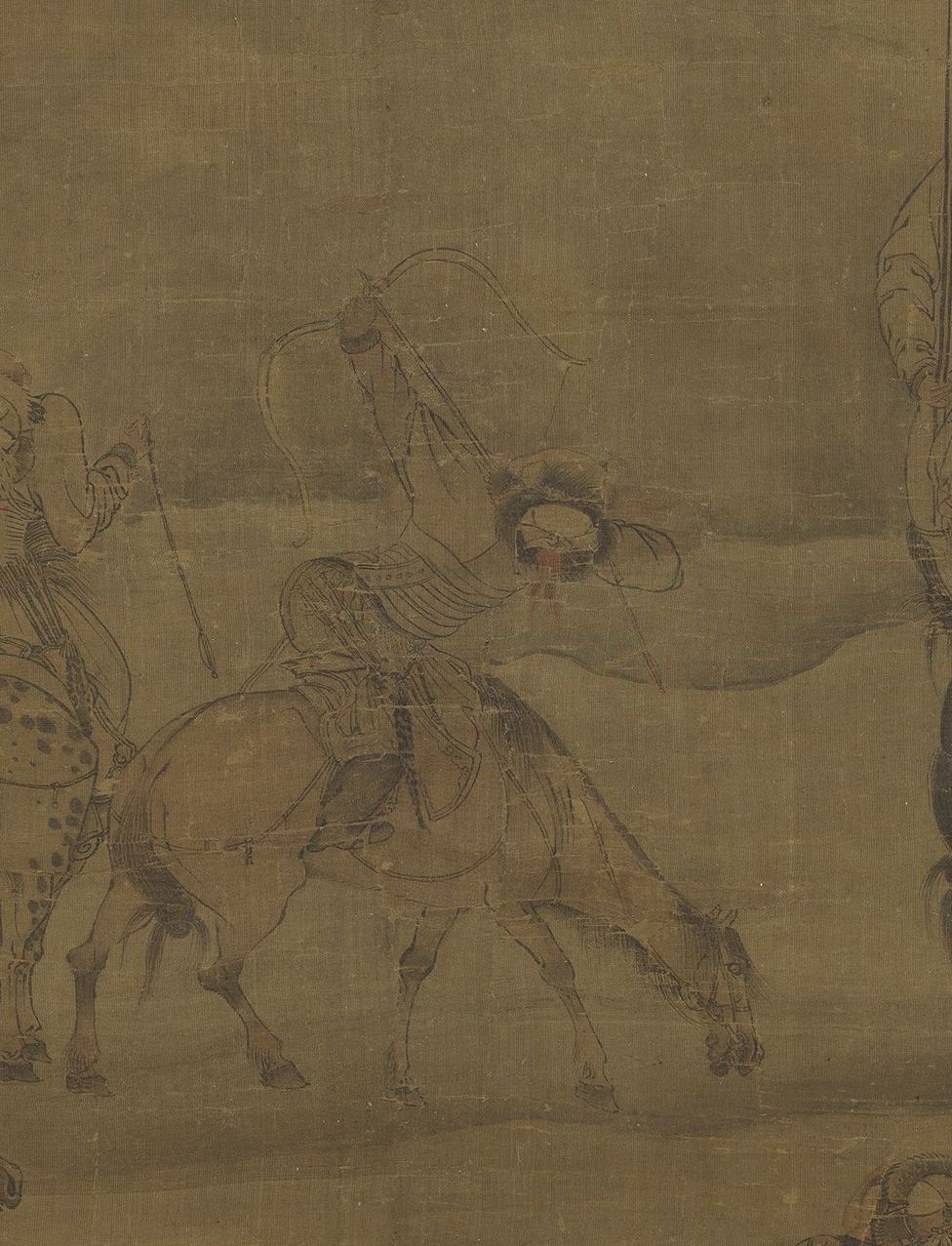
Yuan People Shooting Wild Goose Scroll (detail) Collection of the National Palace Museum, Taipei
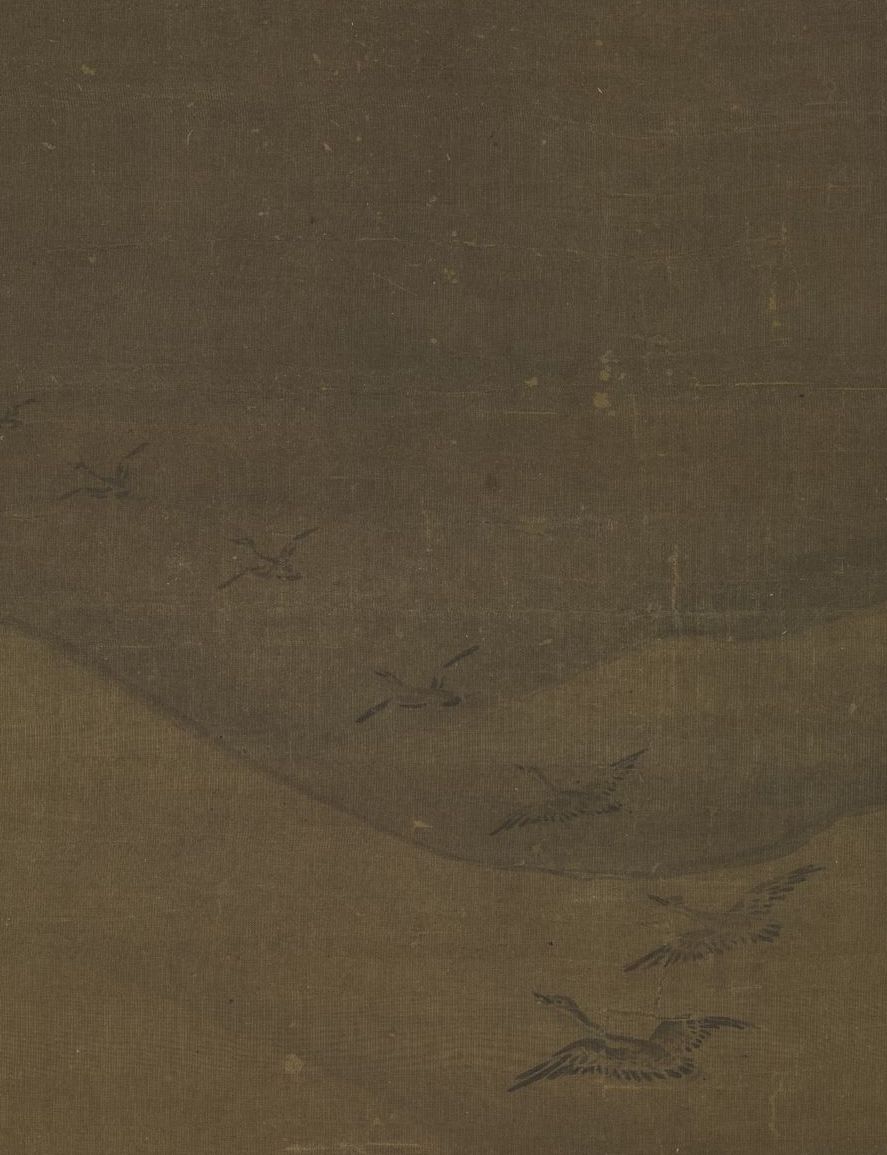
Yuan People Shooting Wild Goose Scroll (detail) Collection of the National Palace Museum, Taipei
There is no author's seal on this painting. Since the hunting formation in the painting is quite similar to Liu Guandao's (the second half of the 13th century) "Yuan Shizu's Hunting Picture" in the Palace Museum, the author should also be an artisan in the court. In the picture, the figures and men of the leaders are very similar to the appearance of Yuan Chengzong Timur (reigned 1265-1307) after his middle age. If we speculate on this basis, this picture was made in about the early fourteenth century.
Ming Lu Ji Qiuzhu waterfowl shaft

Ming Lu Ji Qiuzhu Waterfowl Scroll Collection of the National Palace Museum, Taipei
On the misty autumn night, the bright moon was half-hanging, and four bean geese perched on the slope between the half-hidden hibiscus and reeds. But what the author wants to show is not only the habit of geese who will be vigilant at night by one wild geese when they perch at night, but also a state of mind that expresses feelings with the time and scene, and then draws the desolate autumn night. The brush and ink of painting birds and flowers in the picture are neat and meticulous without being rigid, while the stone painting is more freehand. This kind of work that combines work writing and can grasp the atmosphere of the situation is exactly the painting style that Lv Ji is good at, and he is very good at painting by later painters. have a huge impact.
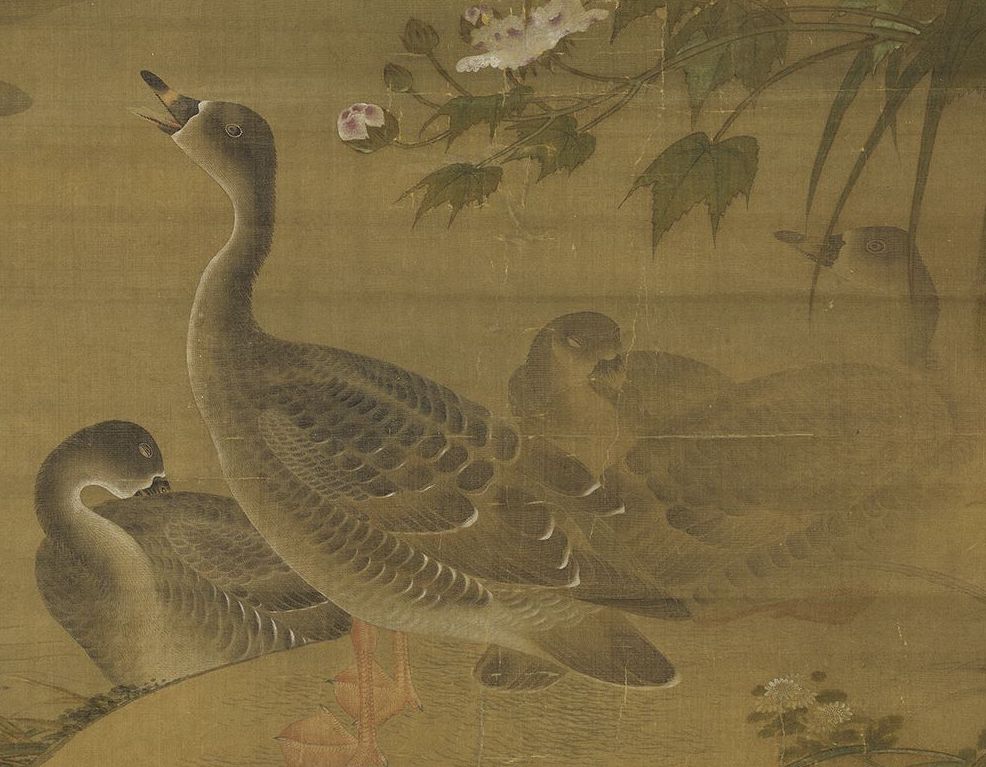
Ming Lu Jiqiuzhu waterfowl axis (detail) Collection of the National Palace Museum, Taipei
Lv Ji (1439─1505), a native of Yin County (now Ningbo), Zhejiang Province. The word Tingzhen, the number Leyu, a fisherman. Emperor Xiaozong Hongzhi (1488-1505) served in the Hall of Renzhi, and was commanded by Jinyi. Flowers and birds first learned Bian Wenjin, and later imitated various famous brushes from the Tang and Song dynasties, combined with handwriting, it became more and more wonderful.
(biography) Ming Lu Ji Luting came to the wild goose chart

(Biography) Ming Lu Ji Luting Comes Wild Goose Scroll Collection of the National Palace Museum, Taipei
Lu Ji's style of painting is divided into two types: meticulous coloring and ink painting. In this painting, the geese, once flying down, raised their heads to welcome, the four geese form a group, quite echoing. The level of ink used is bright and lively, and it is a masterpiece in ink painting, but in terms of style, there is no meaning of Lu Ji's brush like wind. This inscription is added later, with two seals on the lower right, one of which is "the character is good", which is the character of Lin Liang, either by his hand or his disciple, to be tested.

(Biography) Scroll of Lu Ting's Arrival to Wild Goose by Lu Ji in Ming Dynasty (part) Collection of the National Palace Museum, Taipei

(Biography) Scroll of Lu Ting's Arrival to Wild Goose by Lu Ji in Ming Dynasty (part) Collection of the National Palace Museum, Taipei
Reed and wild goose in Minglin

Minglin Liang Lu and Wild Goose Scroll Collection of the Palace Museum
Inscription: "Lin Liang". The seal is indistinguishable.
This "Lu Yan Tu" depicts a pair of geese flying down a pond, and their flapping wings cause ripples on the water surface and swaying reed grass. The author uses pure ink to shape objects with block-faced brushstrokes. The brush and ink are concise and accurate in shape, reflecting the painter's highly mature ink and wash freehand techniques.
In Ming Dynasty Jiang Shaoshu's "History of Silent Poetry", he said that Lin Liang "painted colored flowers, fruits and feathers very delicately. Using ink and wash as the haunting geese, wild geese, and scorpions, his attitude is quite clear. Moved."
Ming Xiang Shengmo's Reed and Wild Goose Scroll
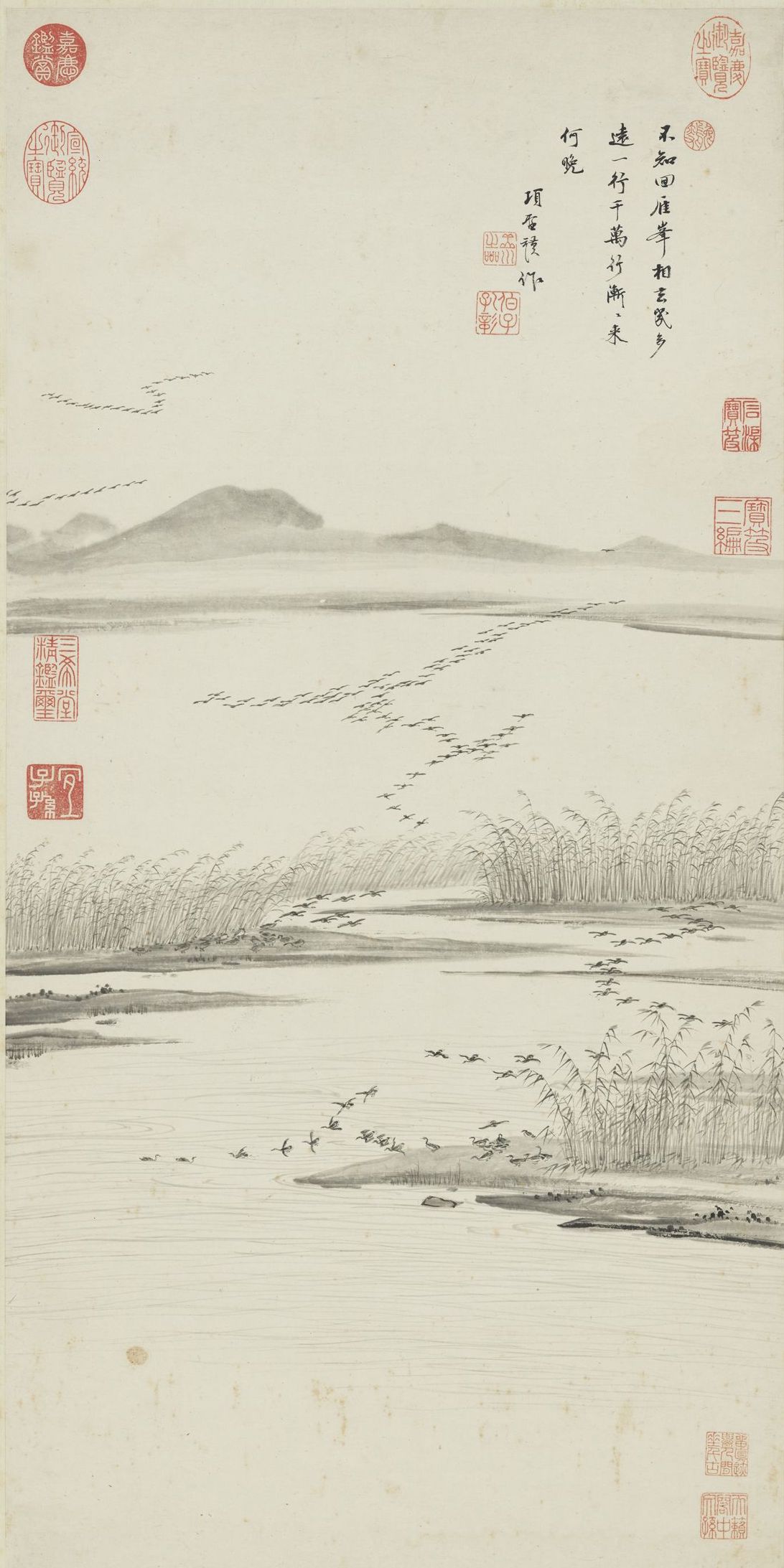
Ming Xiang Shengmo's Reed and Wild Goose Scroll Collection of the National Palace Museum, Taipei
Xiang Shengmo (1597-1658) was the grandson of Yuan Bian. The word is Kong Zhang, the number is Yi'an, and the number is Xuqiao. Works in calligraphy and painting of landscapes. He was a beginner in Wenheng Mountain, expanded in Song Dynasty and took rhyme in Yuan Dynasty. He is the most famous painting in the Xiang family for generations. In this picture, there is a cluster of reeds, and a group of geese are staying, either flying low, or coming from a distance. In the middle of the river and sky, I write about frost, autumn and evening scenes, so that people can see it. There is a Fang "Tian Lai Pavilion Chinese grandson" in the collection mark, which shows his admiration for his grandfather Yuan Bian.
Ming Zhu Fu Luzhou Gathering Geese Chart Axis

Ming Zhu Fu Luzhou Gathering Wild Goose Scroll Collection of the National Palace Museum, Taipei
"Luzhou Gathering Wild Goose Picture" is inscribed by the painter Zhu Fu in official script: "Cut the candle and listen to the rain at night, and occasionally read the small scene of ancient wood jackdaw painted by Shusheng Qian Jun, and I don't feel itchy, because I wrote Luzhou Gathering Wild Goose to match it. A friend of mine, Huang Deqian, was present, and he said that it looks like a water and cloudscape in Xiaoxiang. He had passed the Erfei Temple in the past, but when he revisited this picture, he seemed to be revisiting it, but he was less bitter. Yu then added Cong Xiao in the middle, which was very interesting, and wrote a poem about it: Ye Xiao listened to the rain and said Ba Shan, and then entered the Xiaoxiang Water Bamboo Room. Xiangpu Minghong who is like, Bitian flew away and flew back. Jiayin (1374), the third month of spring, was repaired. Zhu Mengpian recorded in Xiye.

Ming Zhu Fu Luzhou Gathering Wild Goose Scroll (Part) Collection of the National Palace Museum, Taipei
Zhu Fu (active in the late 14th century), a native of Huating, Jiangsu Province, with the courtesy name Meng Bian, the number Cangzhou Sheng, Hong Wuchu, edited and revised Zhongshu Sheren with Hanlin. His talent is elegant, good at painting reeds and wild geese, combining Xiaoxiang water and clouds, and good at landscapes and line drawing figures. Gongci Zhang Hanmo's study, Zhen, Cao, Li, and Zhuan are clear and vigorous, with extraordinary demeanor. I tasted it in the fine forest mountain where the script was written, and it was titled as a seal mound. Zhu Fu was a disciple of Yang Weizhen, a famous scholar at that time, and was highly valued by the Yang family.
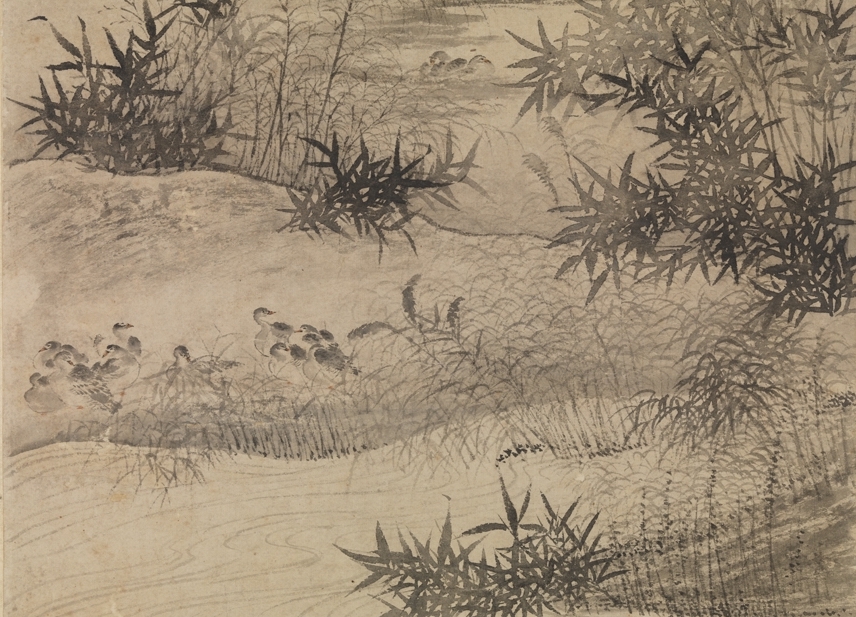
Ming Zhu Fu Luzhou Gathering Wild Goose Scroll (Part) Collection of the National Palace Museum, Taipei
This painting is a scene of sloping sandbars, withered willow rocks, and a group of geese gathered in a reed bush. According to the self-inscription, Luzhou Juyan was painted first, and the bamboo clump inscription was added a few years later.
Ming Dynasty
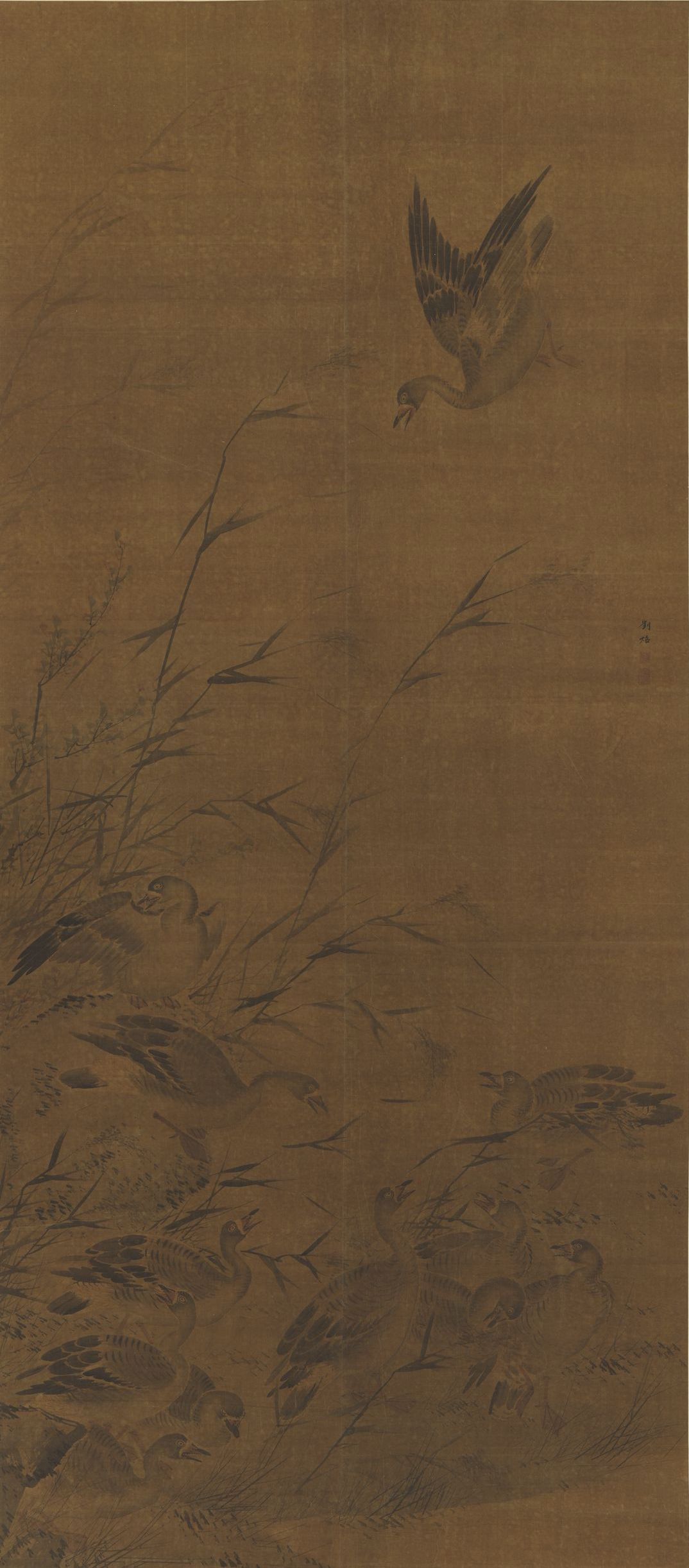
Ming Liu Shao, Lu and Yan Scroll, Collection of the National Palace Museum, Taipei
Liu Zhao, whose birth and death years are unknown, with the word Chaoyun, Kuaiji (now Shaoxing, Zhejiang). He is good at painting feathers and flowers, and likes to chant, and his poetry and paintings are exquisite. The famous painter of ink and wash Luyan in the Ming Dynasty, Lin Liang, who was active in the second half of the 15th century, used a bold and unrestrained pen. The other is Lu Ji (active between the 14th and 15th centuries), who is good at painting flowers and birds in fine brushwork. He also occasionally works with ink and wash. Although his brush is not as rough as Lin Liang's, he is also free and easy. According to the history of painting, Liu Hao was good at large-scale paintings. This painting depicts wild geese swarming along the river, and the brushwork is elegant and elegant, which is closer to the style of Lu Ji's school.
Ming Guodian Jackdaw Pills Goose Axis
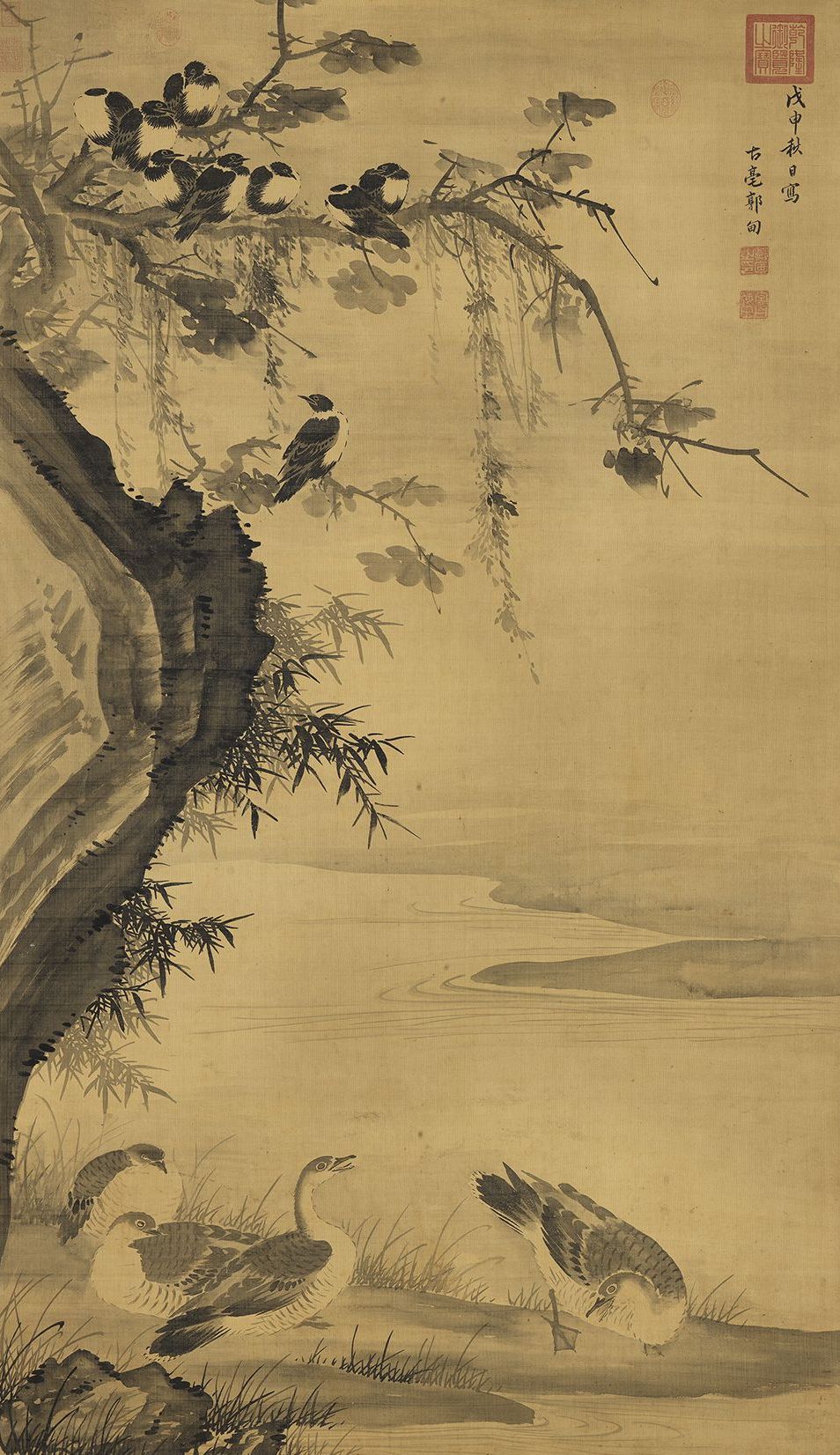
Ming Guodian Jackdaw Su Yan Axis Collection of the National Palace Museum, Taipei
Guo Dian, courtesy name Haitian, was born in Henan, and his date of birth and death is unknown. In this painting, there are geese and crows, the black is beautiful and smooth, the wood and stone are especially good, and the water is wonderful.
Qing Dynasty Zhu Da Lu Yan Chart Axis
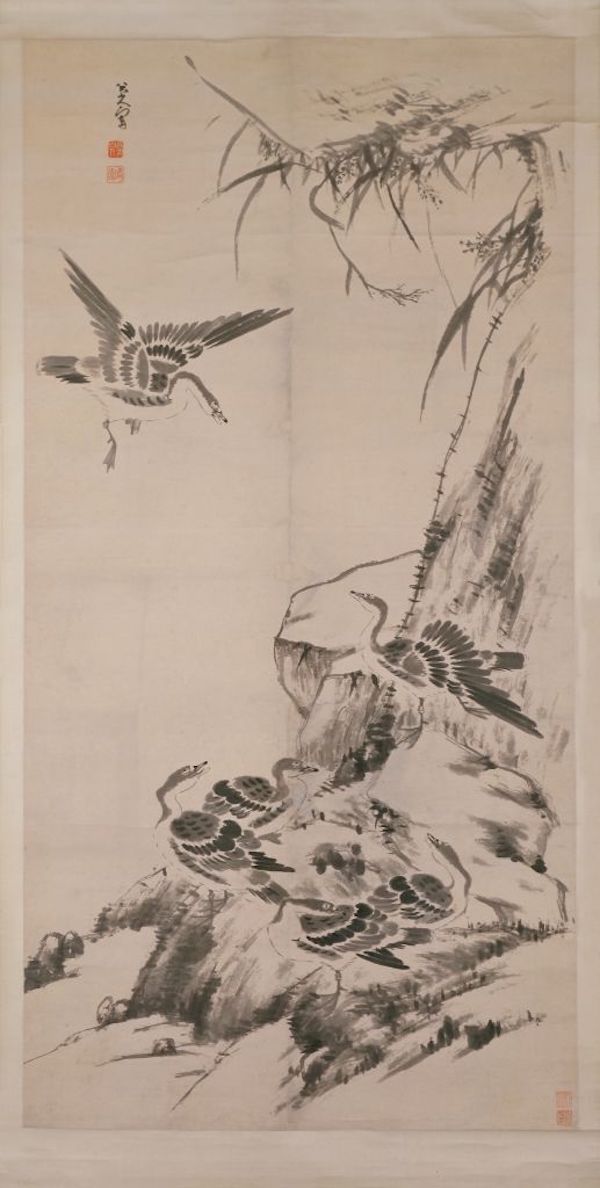
Qing Dynasty Zhudaluyan Scroll Collection of the Palace Museum
It draws the moment when 6 reed geese fly, sing, walk and stop on the waterfront. The shape of Lu Yan is precise and rigorous, and the dynamic and static postures are superb. The feathers on its back are first smeared with light ink, and then dotted with thick ink on the light ink while it is wet, and the soft and dense texture and heavy volume of the feathers are shown where the thick and light inks blend. The brush and ink depicting the mountains and rocks are old and skillful, and the moss on the rocks is dyed with a horizontal brush. The vertical and horizontal are random without losing the rules. .
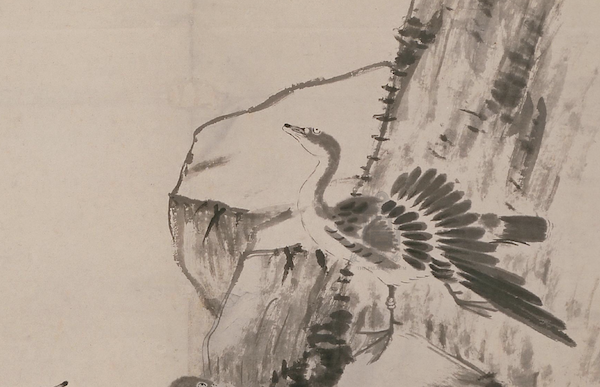
Qing Dynasty, Zhu, Lu and Wild Goose Scroll (Part) Collection of the Palace Museum
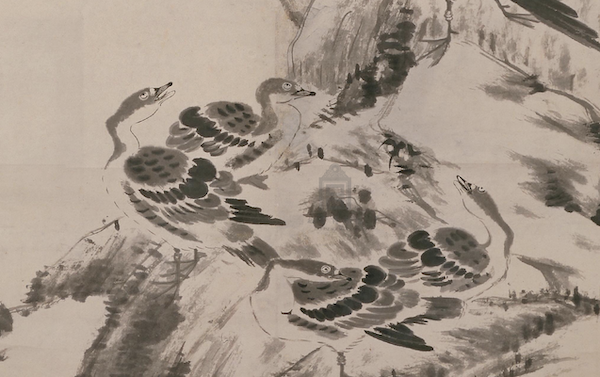
Qing Dynasty, Zhu, Lu and Wild Goose Scroll (Part) Collection of the Palace Museum
Inscription: "Written by Bada Shanren." Inscription "Bada Shanren" in Bai Wenyin, "He Yuan" in Zhu Wenyin, and "True Rewards" in Zhu Wenyin. The collection is printed with Zhu Wenyin, "The Collection of Paintings and Calligraphy of Anci Wang's Shenxiutang".
Qing Huang Shen reed flower double geese figure axis

Qing Huangshen Reed Flower Double Wild Goose Scroll Collection of the Palace Museum
The picture is self-titled: "A half-mountain passes through the rain with the slanting light, and the reeds reflect the clothes of the guest. Outside the clouds, you can see that you are everywhere, and you must send books to the south."
"The half-mountain passes through the rain with the slanting light, and the reeds reflect the clothes on the water." After the autumn rain, the surface of the river is misty and misty, and the reed leaves with the rain are swaying in the wind. The two geese perched under the reed leaves, their eyes closed, their bodies cringed, their heads buried in feathers, revealing the slight chill after the mountain rain. "Beyond the clouds, you can know that you are everywhere, sending books and geese flying south." When winter comes, wild geese fly south. Their figures often arouse people's sadness of lovesickness and parting, hoping to pass on greetings to distant relatives and friends. This painting borrows the scenery to express feelings, and writes the thoughts of distant relatives and friends through Luhua and Qiuyan.
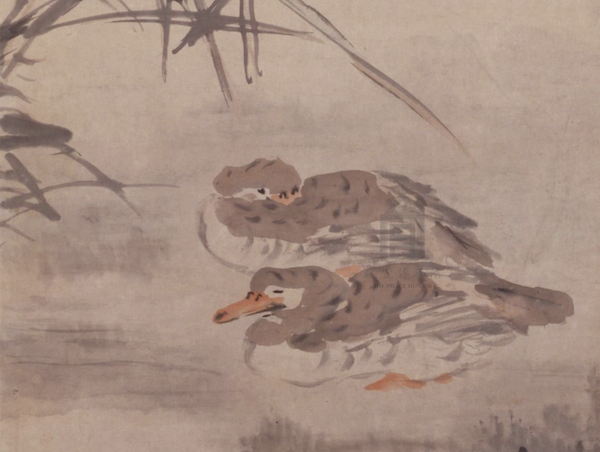
Qing Huangshen Reed Flower and Double Wild Goose Scroll (Part) Collection of the Palace Museum
From this work, we can see Huang Shen's uniqueness among literati painters. He is good at discovering touching scenes in nature, embodying emotions in the scenery, and supplementing them with poetry to point out the meaning outside the painting. In this regard, he and Hua Yan have similar interests, and both of them have the characteristics of both elegant and popular, and they influence each other. In the painting method of this picture, the vast river surface is smeared with ink and wash, and the farther away, the lighter. The reed leaves are integrated into the wild brushwork of cursive script, the brush is swift, and individual branches and leaves are awakened with thick ink, creating a misty artistic conception. The geese are accurate in shape, concise in brushwork, and focus on the depiction of expressions, reflecting the painter's profound realistic modeling ability.
Qingbian Shoumin Reed Wild Goose Chart Axis
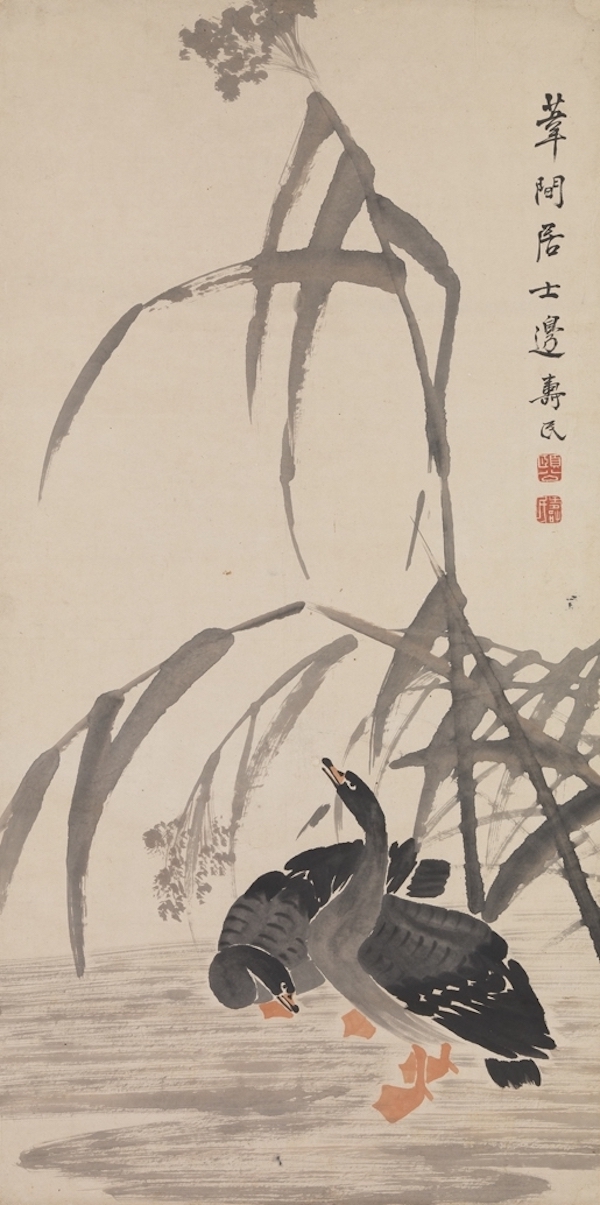
Qingbian Shoumin Reed and Wild Goose Scroll Collection of the Palace Museum
Self-titled: "Bian Shoumin wrote in Baisha Hotel two days after the beginning of winter." The seal is "Yi Gong" and "Shoumin". "Renzi" was the tenth year of Emperor Yongzheng of the Qing Dynasty (1732), and the author was 48 years old.
This picture vividly depicts a small scene of Qiu Yan calling each other warmly. The whole frame is in a vertical composition. The author skillfully draws a tall reed in the close-up view. The vertical shape strengthens the connection between the upper and lower autumn geese and becomes a main line that organically connects the objects in the picture. The reeds and geese are drawn with splashing ink, and the accurate and vivid brush and ink show the author's strong sketching ability.
Qingbian Shoumin Reed and Wild Goose Fan Page

Qingbian Shoumin Luyan Figure Fan Page Collection of the Palace Museum
The fan page has a self-titled: "Yu Ling and Lu Yu are colorful, how can they chase the wild scorpion. Yesterday's autumn wind saw Jiao He, and his party broke through the blue sky and clouds. It is titled Qingpin, the eldest brother of Yi Wengyan. "Qian "Shoumin" white print, "Yi Gong" Zhu Wen seal.
This picture is a painting given to a friend by the author. The picture depicts the scene of two geese on the edge of the reed pond, about to go and stop. In order to draw good geese, Bian Shoumin once "knitted the grass and reeds" and was in the company of geese. Every day, he carefully observed the various postures of geese walking, lying and flying. Therefore, the geese in his paintings are anatomical and have vivid and realistic shapes. Features. This picture is not drawn, but is drawn directly in ink or color, showing a certain artistic level.
Qingbian Shoumin Reed Wild Goose Chart Axis
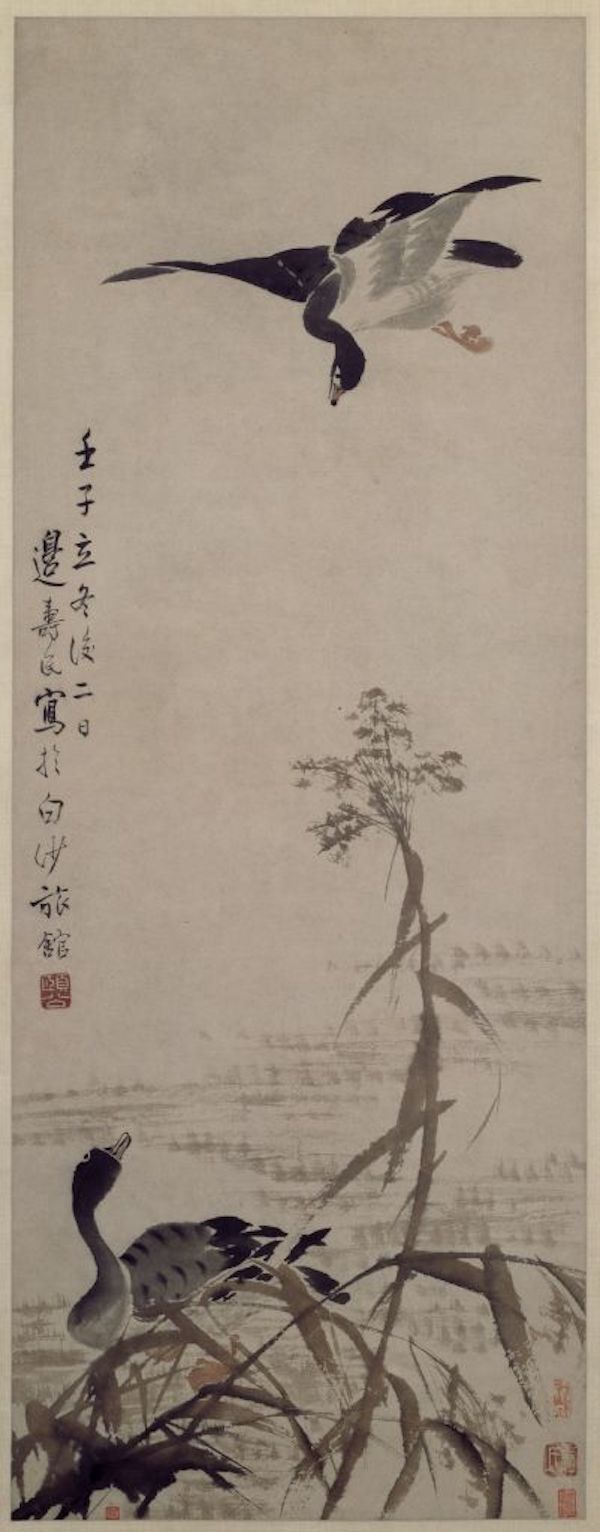
Qingbian Shoumin Reed and Wild Goose Scroll Collection of the Palace Museum
In the drawing, there are sand and reeds, water plants are dotted, and two geese are leaning and leaning, resting leisurely. The whole picture is free and easy to use, and the reeds are written in dry ink, which is vigorous and refreshing; the reeds are dyed with bald brushes, fluffy and natural; the goose-shaped body is written with splashing ink, and only a little ochre yellow is applied between the beaks and feet, which not only enriches the color The change of , and achieves a harmonious unity with the shades of black ink used in the main body of Luyan. This kind of freehand ink-splashed reed geese is a unique creation of Bian Shoumin.
Qing Kesi Reed and Wild Goose Scroll
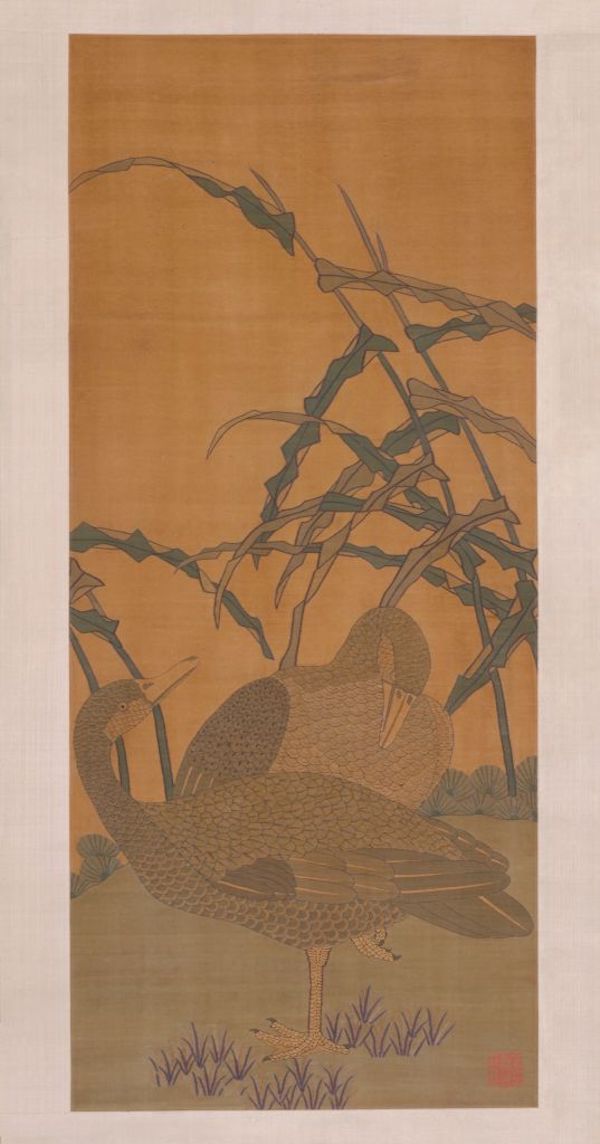
Qing Kesi Reed and Wild Goose Scroll Collection of the Palace Museum
The picture is painted with patterns such as reed wild goose, potuo and grass on the natural color ground. The picture is basically matched with stable colors such as green, brown, lake color, fragrant color, dark green, etc. The composition is simple and the shape is realistic. The work is woven using techniques such as flat sash, sing-scaling, structuring and dangling. The author skillfully handles the bending and changes of the lines, and vividly expresses the fluttering of the reeds blown by the wind and the changes of light and shade under the folded leaves. Quite natural interest. The two reed geese looked peaceful and contented. The combination of movement and stillness is full of harmony and natural pleasure. The seal below the picture is the collection seal of "The Sixth Emperor and Prince Shuokong".
Japanese Kano Yashin Ashi Axis

Japanese Kano Yashin Ashi Axis Collection of the National Palace Museum, Taipei
Kano Yashin (1613-1685), a master of the Japanese "Kano School". Kano Takanobu's third son, No. Yongzhen, Mu Xinzhai, Jing Xianzi, Lefuzhai, Shiro Jiro. Also known as Fujiwara Yashin. He lost his father when he was six years old, and he was able to draw and explore the secluded places. His two older brothers taught, and later entered Edo (today's Tokyo) with his brother. And because he lived in Nakabashi, the Kano family was also called Nakabashi Kano family. Syriac Eyes. The characters, landscapes, flowers and birds are all exquisite.
This picture is included in the catalogue of the special exhibition of bequests and monuments in Dafengtang.
Modern and Modern He Huaishuo Autumn Wild Goose Axis
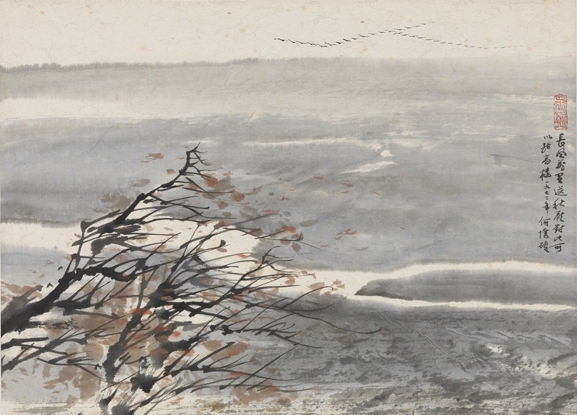
Modern and Modern He Huaishuo Autumn Wild Goose Scroll Collection of the Palace Museum, Taipei
This painting is self-titled by the artist in running script: Changfeng Wanli Sending Autumn Wild Goose, You can enjoy high-rise buildings in this regard. 1972. He Huaishuo.
(This article is compiled from the official websites of the Palace Museum and Taipei Palace Museum.)
